Samsung The Frame 2025 is a TV like no other – and even though it has competition now, it still does it best. The matte panel, flush with the wall, and one thin cable thanks to the One Connect module make the device resemble a piece of art more than any other screen. The Art Store app continues to offer the best scans of artworks on the market (even if they are subscription-based), and with interchangeable frames, we can match the TV to the interior almost like furniture. When it comes to the picture itself, because after all, we are also talking about a regular TV, there are no major changes, but also no disappointments compared to last year's model LS03D. The Frame still offers high native contrast and solid brightness at 600 nits, which combined with the matte coating provides very comfortable daytime use. The colours are not as vibrant as in glossy screens, but compared to competitive matte constructions – they fare the best. A novelty is the 144 Hz refresh rate, though in practice it will mainly benefit PC gamers. And indeed – in terms of features for gamers, The Frame has nearly everything: low input lag, support for variable refresh rate (VRR), automatic game mode (ALLM), Game Bar, and a unique motion smoother designed for gaming. Unfortunately, not everything is as perfect as it might seem. Why? Because the HGiG mode is missing, which suddenly disappeared from the latest version of the Tizen system. And here Samsung really should respond, as for many gamers this is a key element in choosing a screen. And we fully understand that. Although LS03F The Frame 2025 does not bring major revolutions, it is still a unique TV that, aside from its appearance, offers a quite solid picture and advanced gaming features. It’s just a pity that year after year we also receive new compromises.
- Matching (Score)
- Our verdict
- TV appearance
- Where to buy
- Contrast and black detail
- HDR effect quality
- Factory color reproduction
- Color reproduction after calibration
- Smoothness of tonal transitions
- Image scaling and smoothness of tonal transitions
- Blur and motion smoothness
- Console compatibility and gaming features
- Input lag
- Compatibility with PC
- Viewing angles
- TV efficiency during daytime
- Details about the matrix
- TV features
- Apps
- Playing files from USB
- Sound
Samsung The Frame 2025 (LS03F) vs Samsung S85F OLED
Direct compare
The Frame / LS03FAU
S85F / FAE / FAU
Available screen sizes: 55”

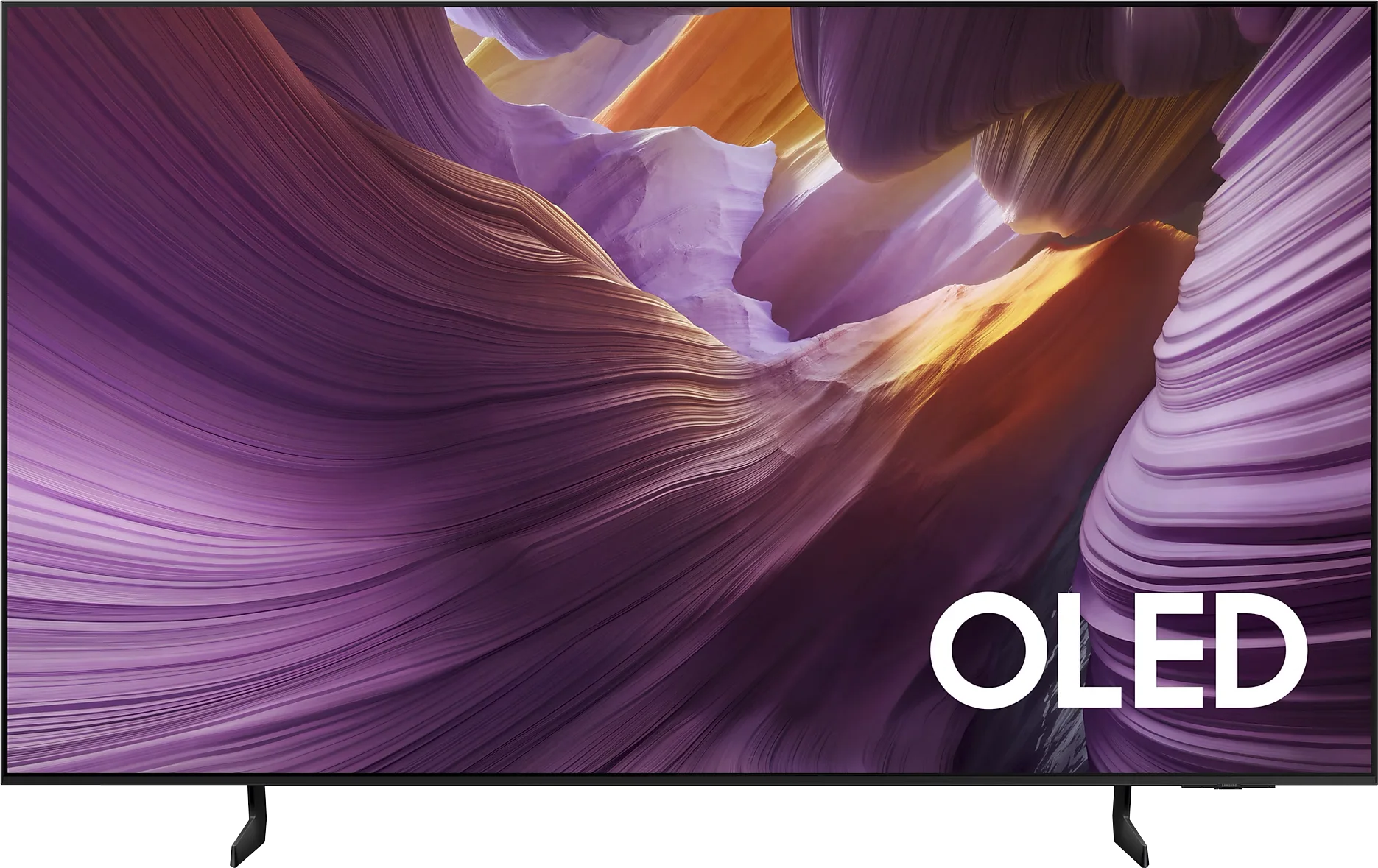
Panel type: LCD VA
Resolution: 3840x2160
System: Tizen
Model year: 2025
Complete the survey to find out the result

Panel type: QD-OLED
Resolution: 3840x2160
System: Tizen
Model year: 2025
Complete the survey to find out the result

Overall rating
7.0
8.0
Movies and series in UHD quality
6.8
8.3
Classic TV, YouTube
6.5
9.0
Sports broadcasts (TV and apps)
6.4
8.8
Gaming on console
8.3
9.3
TV as a computer monitor
8.2
7.6
Watching in bright light
6.3
5.1
Utility functions
8.1
7.2
Apps
8.7
8.7
Sound quality
6.0
7.2
Complete the survey to find out what fits your preferences
Advantages
Matte panel effectively reduces reflections
Screen customisation option with interchangeable frames + art mode
Free add-ons including wall mount + OneConnect module
High native contrast
Good brightness
High refresh rate - 120/144Hz
Plenty of features for gamers - VRR, ALLM, Gamebar, proprietary motion smoother functioning in games
Outstanding black levels and contrast
Amazing colour palette coverage thanks to the QD-OLED panel
Great picture quality in SDR and HDR content
High colour accuracy after calibration
Very good motion smoothness – 120 Hz OLED panel
Rich set of features for gamers: VRR, Game Bar, low input lag
4 HDMI 2.1 ports with full 48 Gbps bandwidth
Advanced and smoothly operating Tizen system
Solar Remote with multiple capabilities
Disadvantages
No HGiG mode – makes precise HDR settings on the console difficult.
No DTS support – requires additional equipment for some films on Bluray discs.
Paid picture mode
No USB recording function and PiP
No Dolby Vision
Slight cherry black under very strong external light (not visible when watching in cinema conditions)
No HGiG function*
* This function disappeared with software update 1110.7 – we are monitoring this situation closely.
Our verdict
The Samsung S85F with a QD-OLED panel is capable of surprising – and in a very positive way. Even before the tests, we did not think that in the case of TVs often referred to in the context of "panel lotteries", one could come across something that would benefit the user. Yet, in this case, particularly with the 55-inch version, it has fully succeeded. The QD-OLED panel, as expected from organic technology, offers near-perfect blacks and contrast in cinematic conditions. However, the difference lies in the way the colours are rendered – here it is simply exceptional. The colour gamut coverage is impressive, and after a slight calibration, the colours become almost exemplary. Motion fluidity is also at a very high level. The 120 Hz panel handles both sports and action films excellently. And if someone plans to connect a console to the S85F, they will receive a full set of advantages: low input lag, variable refresh rate, Game Bar, and full HDMI 2.1 support. In everyday use, we were supported by the Tizen system – closed, but extremely polished. It responds quickly, offers a rich selection of apps, and features like AirPlay and voice control make it hard to find anything more complete in this category. True, the S85F is not without its flaws. However, the balance of pros and cons is exceptionally favourable here. One could even get the impression that it is one of the best TVs in its price segment.
TV appearance
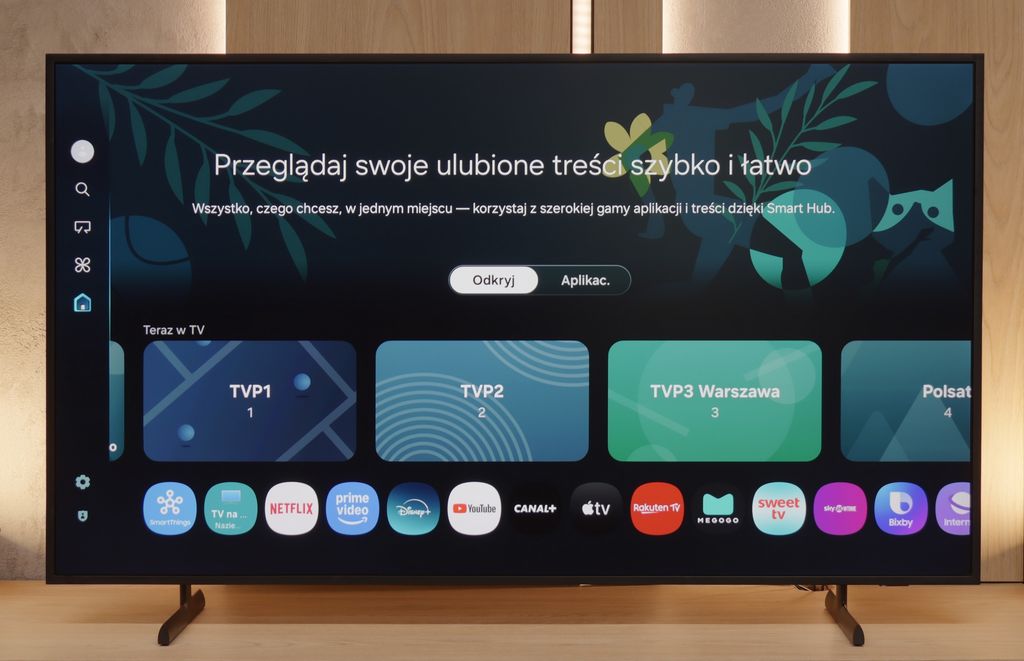
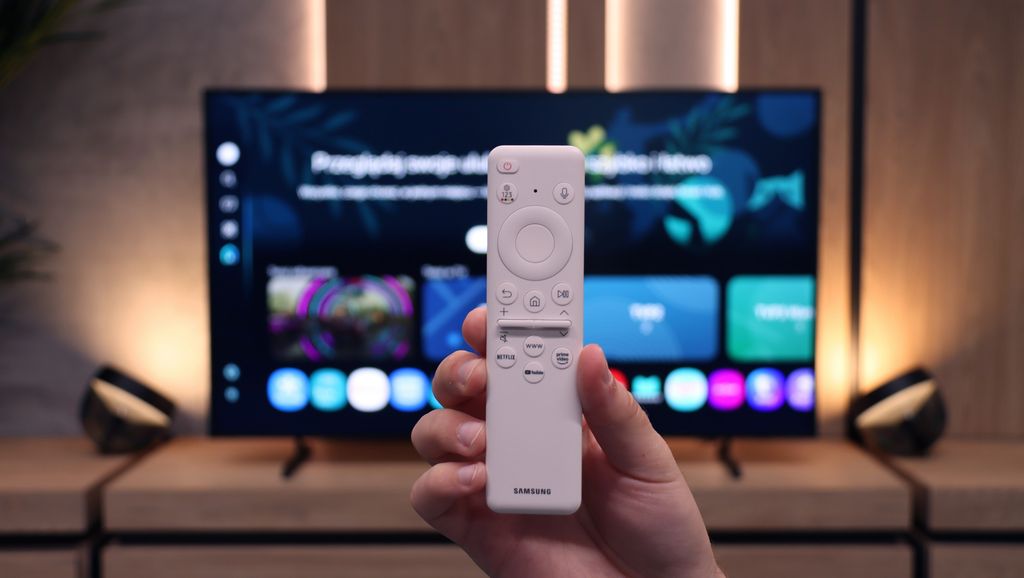

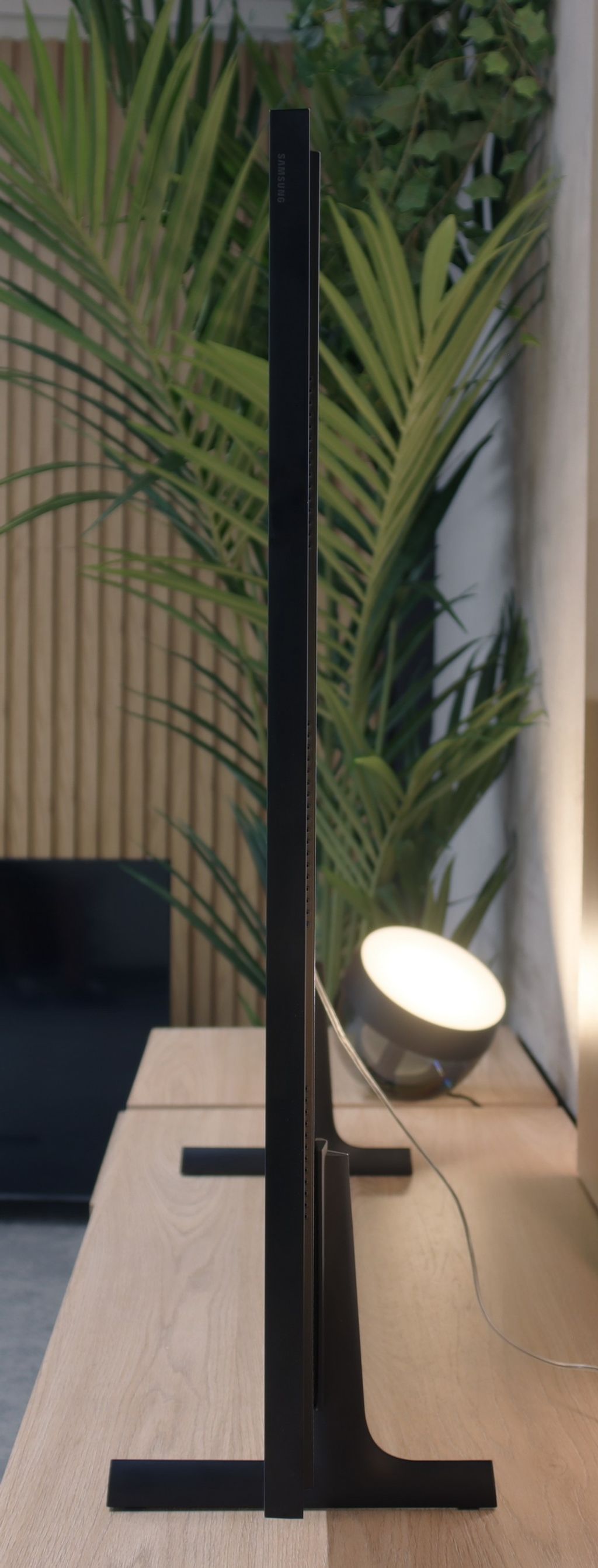
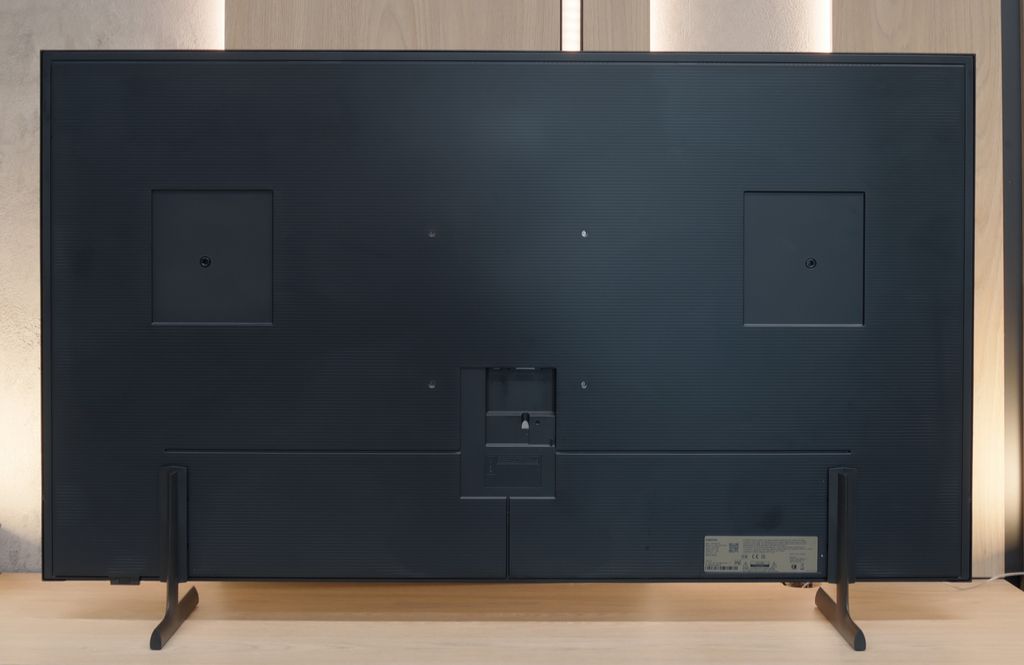
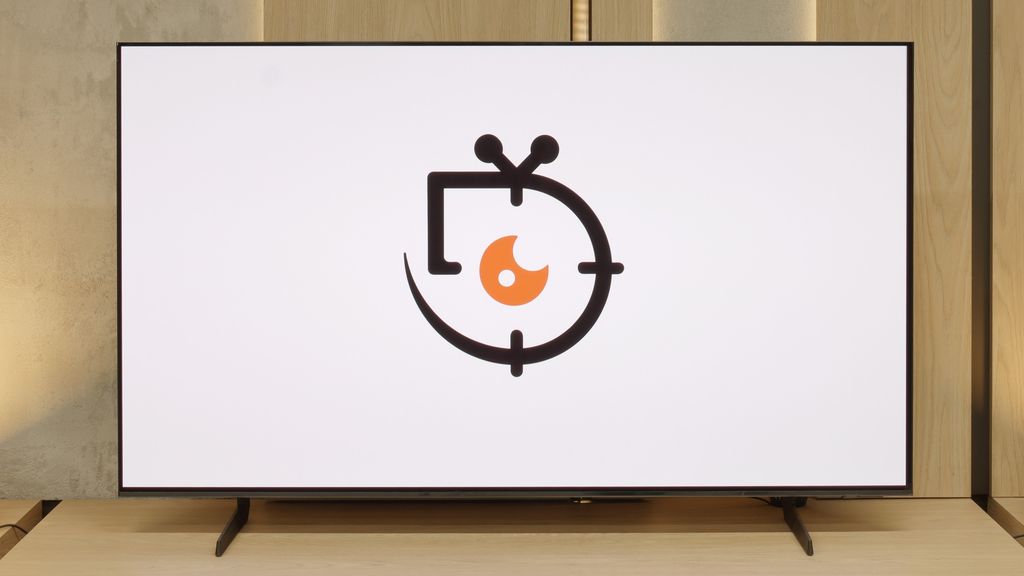

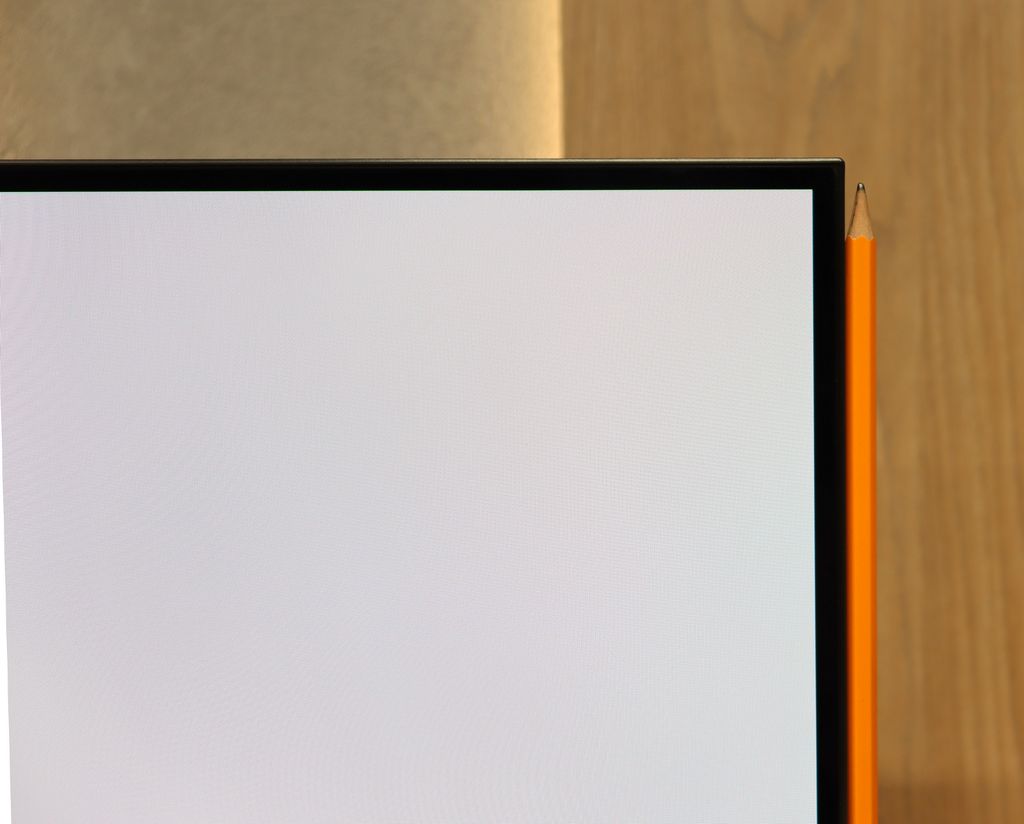
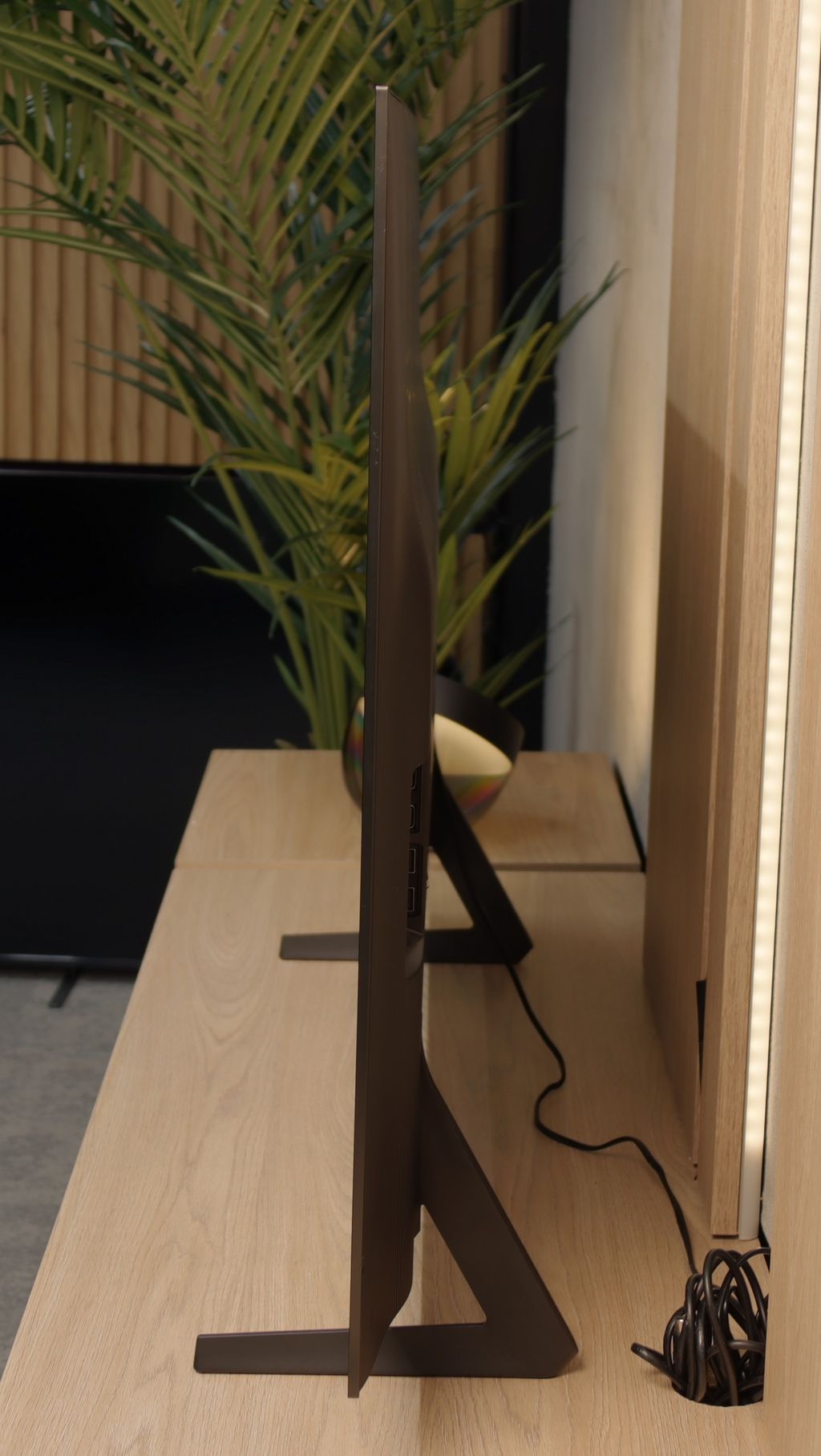
Contrast and black detail
6/10
10/10
Local dimming function: No
Contrast:

Result
4,800:1

Result
4,750:1

Result
14,900:1

Result
4,500:1

Result
4,300:1

Result
∞:1

Result
∞:1

Result
∞:1

Result
∞:1

Result
∞:1
Halo effect and black detail visibility:
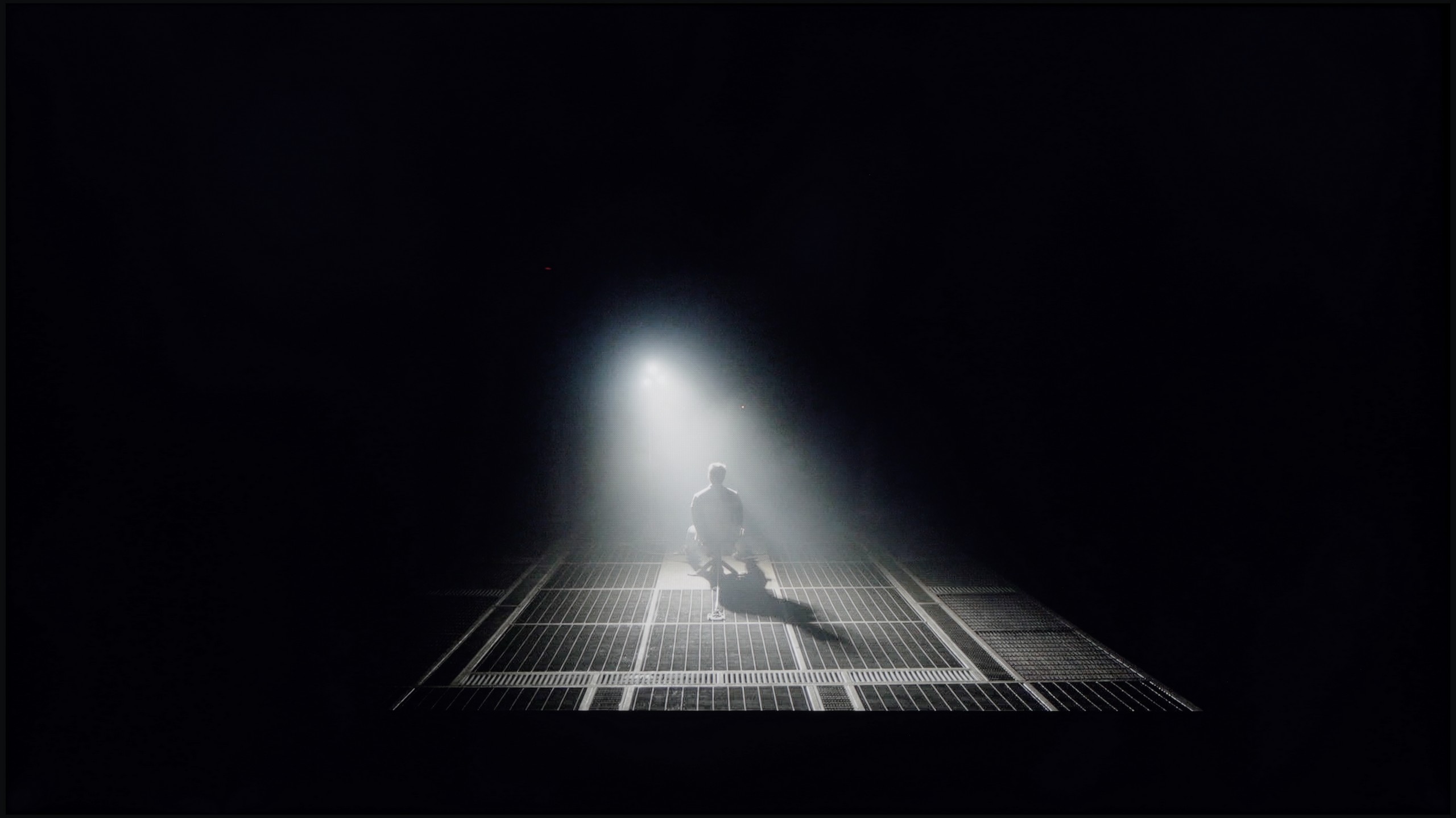
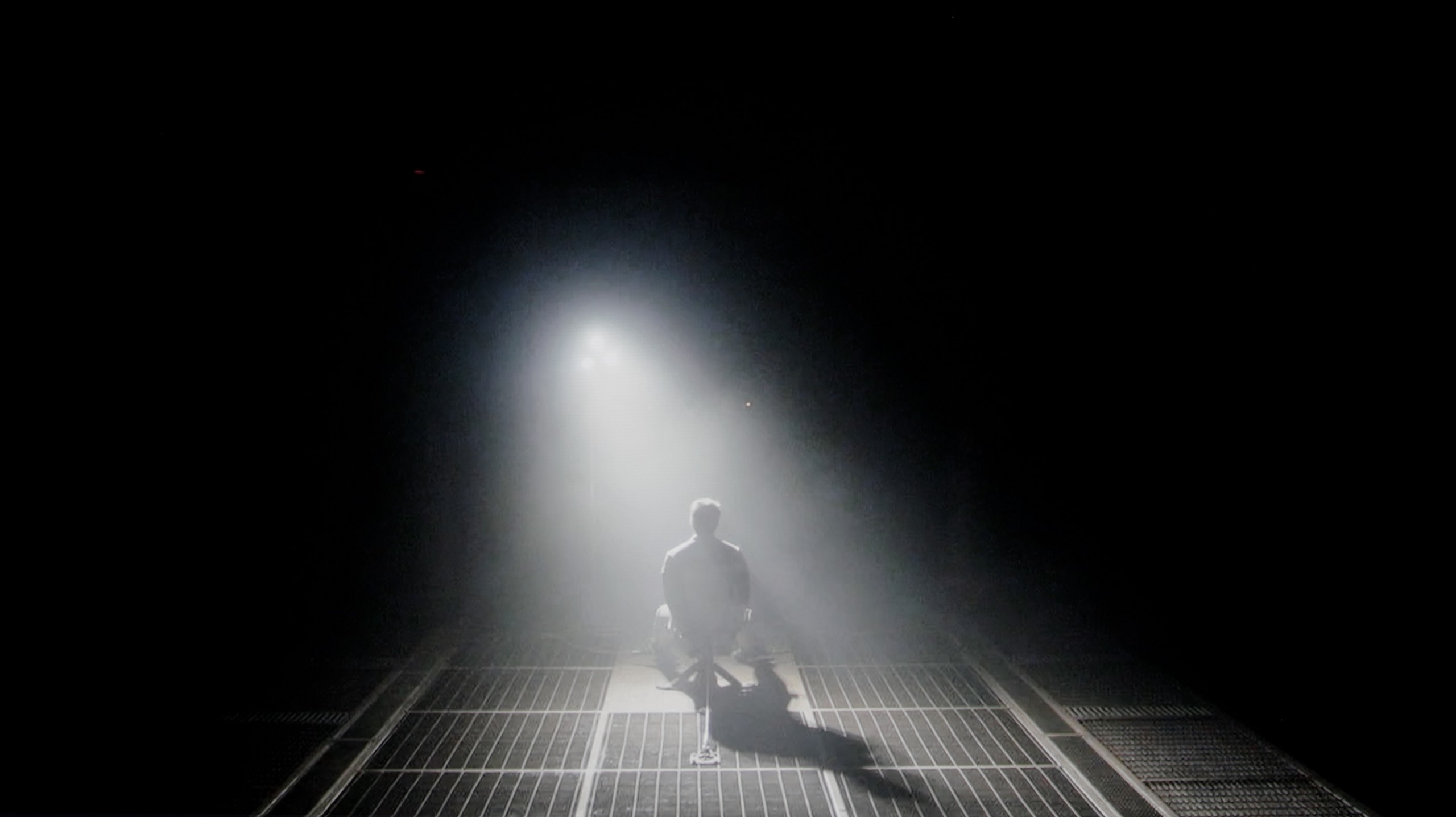
The year 2025 is shaping up to be quite interesting when it comes to lifestyle televisions. Why? Because Samsung has prepared two versions of the iconic model The Frame – one standard and the other with the addition of "Pro". In this review, we take a look at the version without "Pro", which – as we will soon see – makes a significant difference. The standard model LS03F lacks any local dimming technology, unlike its more expensive sibling. This is important as it affects not only the overall picture quality but primarily how this television handles black levels.
The VA panel used in The Frame 2025 has a high native contrast – and this obviously works in its favour. In the tested movie scenes, details in the dark areas of the image were well visible, nothing blended together, and there was no uniform black/light blob. For the average viewer, this will be perfectly sufficient. But of course, not everything is ideal. The lack of local dimming means that the black levels on this television are not perfectly deep – they resemble a dark navy blue rather than pitch black. Additionally, in our tested unit, we noticed slight blooming on the right side of the screen, but this may simply be the "character" of the unit rather than a rule. Theoretically, one could try to improve the perception of black by backlighting the screen – for example, with an LED strip – but in the case of The Frame, that’s rather impossible, as this television is meant to sit flush against the wall like a piece of art. So to achieve better blacks visible to our eyes, we are forced to watch LS03F with the lights on. Such is the charm of this technology.
Samsung S85F in the 55-inch version has something special – it features a QD-OLED panel. This might sound quite surprising, but that's the fact, at least in Poland. So the question arises: is the difference compared to last year's S85D with a WOLED panel even noticeable? Yes, although in this specific test – black levels and contrast – it practically makes no difference.
Regardless of the scene, the S85F presents infinite contrast and perfect blacks that we expect from any OLED. These results can impress even the most demanding film enthusiasts. It's worth remembering that only TVs with organic panels can provide such deep blacks – and it doesn't matter whether it's WOLED or QD-OLED. So if you dream of a screen that can 'turn off' the light in a scene just as effectively as a boutique cinema in a dark room, the S85F is one of those TVs.
HDR effect quality
6/10
6.2/10
Luminance measurements in HDR:

Result
642 nit

Result
589 nit

Result
574 nit

Result
584 nit

Result
631 nit

Result
666 nit

Result
703 nit

Result
742 nit

Result
732 nit

Result
433 nit
Scene from the movie “Pan” (about 2800 nits)


Scene from the movie “Billy Lynn” (about 1100 nits)


Static HDR10


Dynamic: HDR10+
Dynamic: HDR10+


HDR luminance chart:
Samsung S85F OLED
Luminancja HDR
Luminance of RGB colors
Samsung The Frame 2025 (LS03F)
Luminancja HDR
Luminance of RGB colors
The Frame LS03F is a television that can surprise with its brightness. The maximum luminance reaches around 650 nits, which already looks solid on paper. But as we know – lab tests are one thing, and real film scenes are quite another story. When watching HDR materials in natural conditions, The Frame 2025 maintains very good results. In most film scenes, peak brightness stayed at around 550–650 nits. This is enough to feel the difference between standard picture and that in HDR quality – bright highlights, reflections on water, or moonlight look distinct and impressive.
It's also worth noting that the LS03F is a QLED television, which translates to solid colour saturation. The coverage of the DCI-P3 colour space reaches about 92%, allowing for vibrant, intense colours in HDR content. It's not at the level of top premium models, but for a lifestyle screen – the result truly deserves recognition.
As an OLED, the Samsung S85F can shine – literally. In favourable conditions, it can generate brightness exceeding 750 nits. This is significant because most films are created with displays aiming for around 1000 nits. In practice, this means that in scenes with moderately large, bright elements, the picture can look absolutely stunning. However, it's not always so rosy. When an enormous amount of light appears on the screen – whether it's an expansive, bright background or an entire frame filled with white – the S85F must tone it down. Brightness can drop by even four times in such scenes. This limitation is well-known to anyone familiar with OLEDs in this price segment, so we don't view it as a particular fail. However, something that deserves praise is what sets this model apart from the competition – colour gamut coverage. Thanks to the QD-OLED panel, our colour meter indicated values exceeding 100% coverage of DCI-P3 and an impressive 86% for the ultra-wide BT.2020 palette. Such results are hard to find even in televisions that cost several times more.
Factory color reproduction
7.1/10
5.5/10

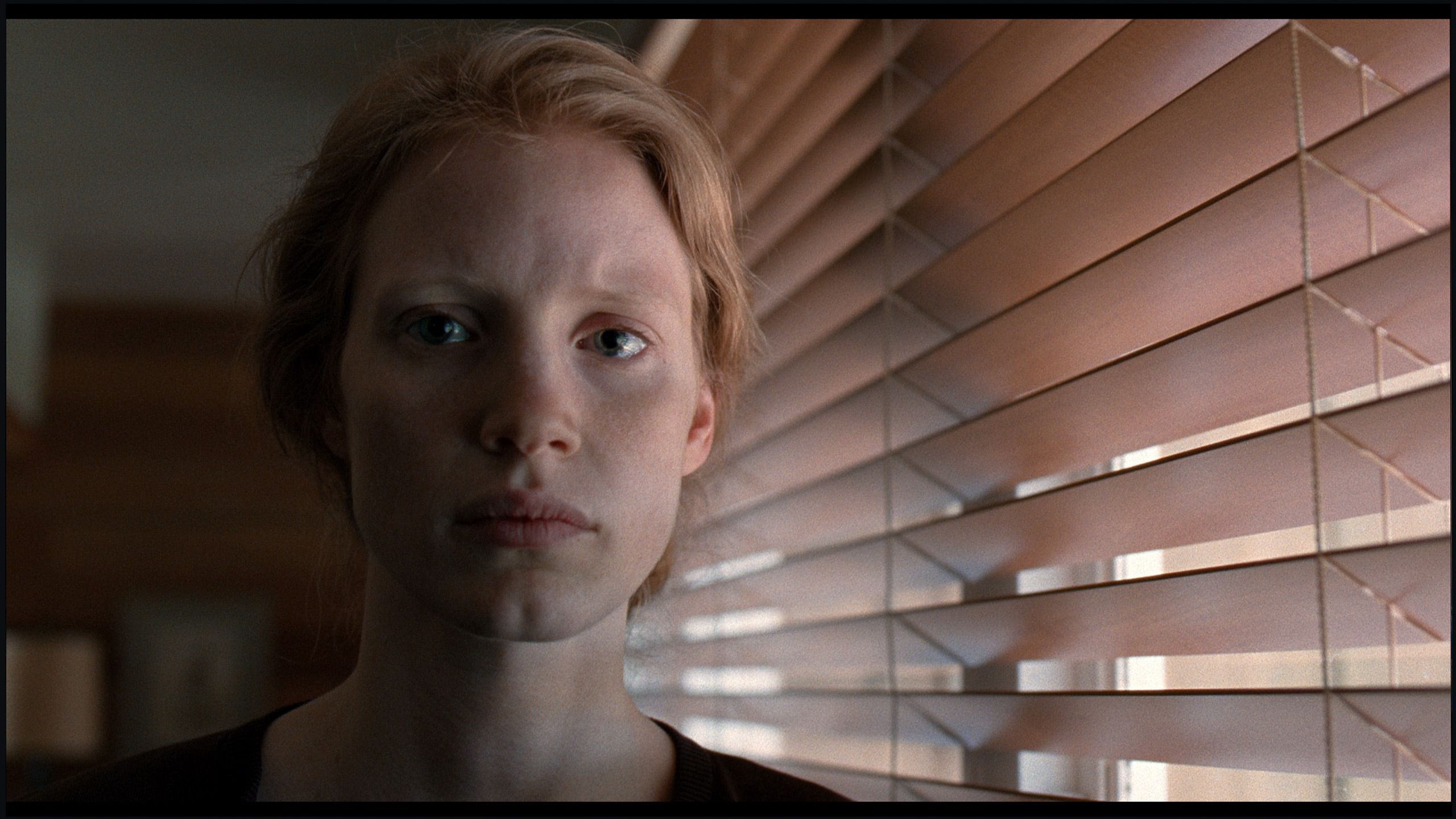
Factory Mode
After calibration
When it comes to picture quality right out of the box, even in Filmmaker mode, which is supposed to be the closest to reference, there were some issues. In both HD and 4K HDR content, we noticed clear deviations in white balance. The picture was heavily skewed towards red and blue, giving the screen a distinctive pinkish hue. This effect was most noticeable in bright scenes – for example, in shots with a lot of white, where neutral light should naturally dominate. In such moments, the screen clearly took on pink tones, which is also evident in the attached comparative photo. As for brightness characteristics – it wasn't as bad as one might expect given such colour inaccuracies. Analysis of the gamma curve and EOTF showed a slight brightening of the image compared to the reference, but not enough to drastically spoil the viewing experience.
Samsung, as befits a manufacturer with ambitions, has equipped the S85F with a mode called Filmmaker. Its task is simple: to make the colours on the newly purchased television as faithful as possible to what the director intended to show us. Sounds great… but, as is often the case, a theory that sounds wonderful doesn’t always translate into perfect practice.
In the tested unit, it quickly became apparent that the image – due to an excess of blue and red – looked as if someone had gone a bit overboard with the saturation. As a result, there were quite significant colour errors, particularly in 4K content. On top of that, there was an issue with brightness – the S85F could brighten most scenes more than it should, stripping them of the intended mood.
Fortunately, Samsung televisions, including the S85F, offer an impressive number of settings for advanced calibrators. This means that we could see what this panel is really capable of when it gets into the right hands.
Color reproduction after calibration
8/10
9.3/10




After calibration, the movie mode gained a completely new quality. The issue of the pink tint, which was previously clearly visible, especially in bright scenes, has been effectively eliminated. Colours started to look significantly more natural, and the white balance no longer dominated the rest of the image. It was no longer the same oversaturated "picture from a box" – everything took on coherence and a cinematic character. Additionally, the tendency of the TV to slightly brighten scenes, previously visible in the EOTF curve analysis, has been partially corrected. Of course, within the limits of what the design allows without local dimming – it's difficult to speak of perfect brightness management here. Nevertheless, the final effect was definitely closer to what one might expect from a mode named Filmmaker.
Thanks to the huge number of settings in the menu, we managed to bring the S85F almost to perfection. White balance in SDR content? Literally perfect – deviations do not exceed a value of "1". So we can confidently say that in materials with not too high dynamics, we have an image that's close to reference.
In HDR content, minor issues appeared, but they don't have much significance in practice – most errors fall below the threshold of perception, which is a value of "3". We also managed to tame the S85F when it comes to brightness management – the EOTF curve, even in films, holds nearly perfect straight line. This is one of those cases where after calibration, you can comfortably forget about the settings and simply watch movies and series at the highest level.
Smoothness of tonal transitions
9/10
7.9/10
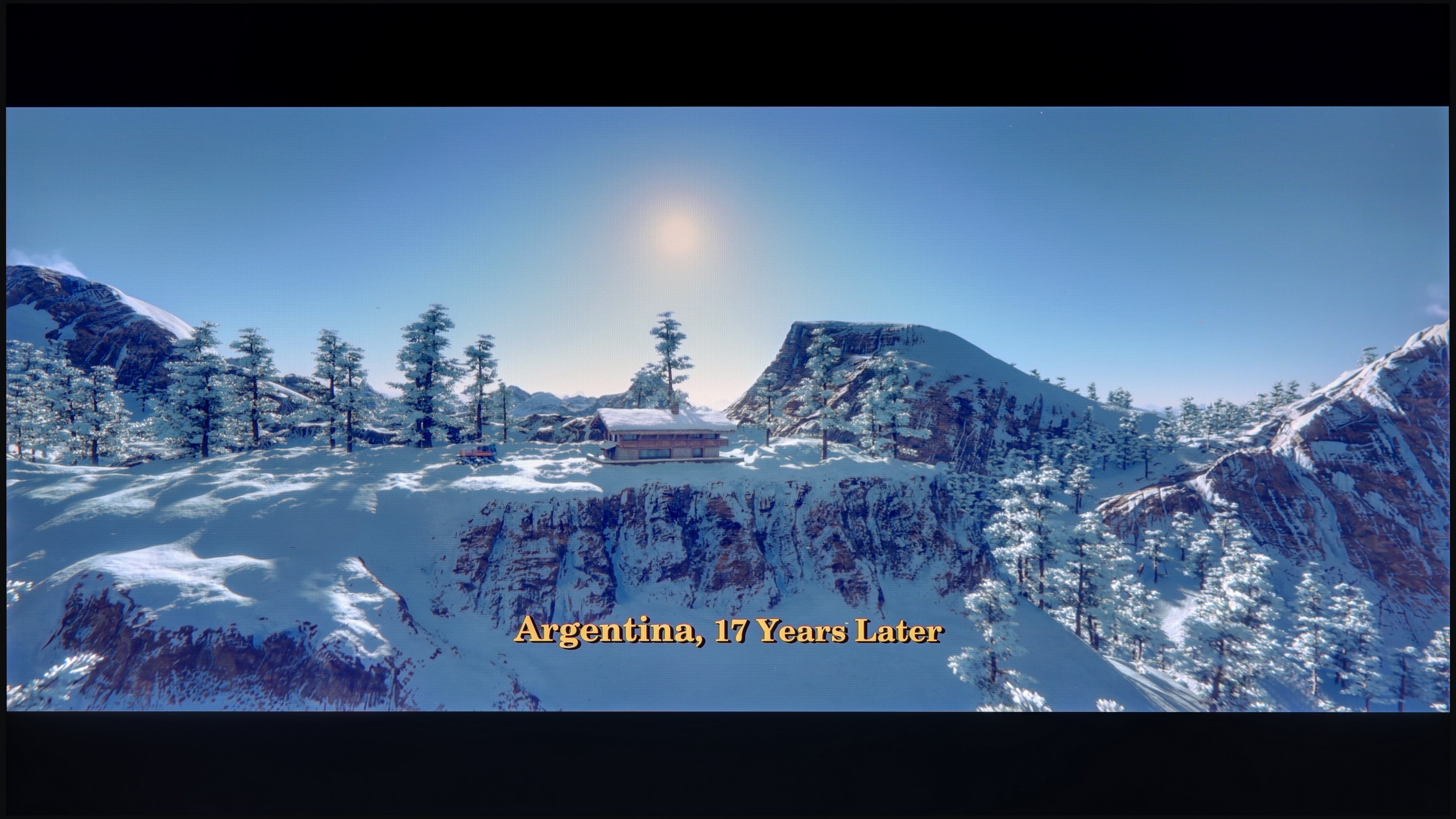



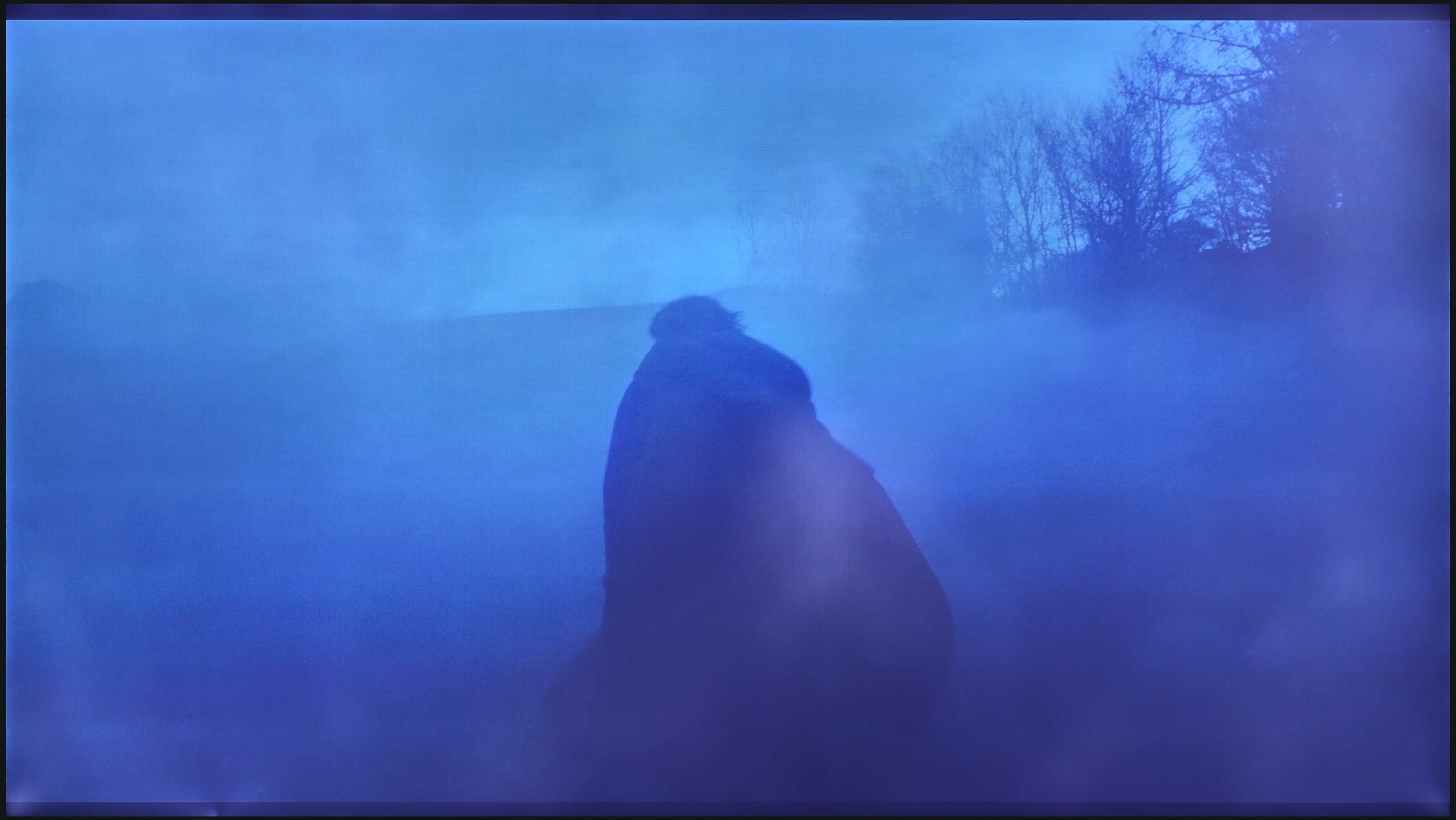




In terms of the smoothness of tonal transitions, the LS03F maintains a high standard – just like last year's models. The television didn’t have any issues during testing of more challenging film scenes, where visible transitions between shades can easily occur. The colour gradation performs very well here – both in lighter and darker parts of the image. We did not observe the typical banding effect or any other disturbances that could be noticeable while watching films. If we were to nitpick, in the most demanding scenes – with subtle transitions and delicate gradients – minor imperfections can be seen. But only if you get really close to the screen and start analysing the image from an unintended distance.
Thanks to the QD-OLED panel, colour blending on the S85F is really very good. It's particularly worth noting how it performs in the darkest, most demanding scenes – where most TVs start to struggle, this model operates almost perfectly.
Interestingly, a slight stumble can be noticed in those easier, brighter shots. There is minimal colour banding, but it's so subtle that it's hard to believe it would genuinely bother anyone during viewing.
Image scaling and smoothness of tonal transitions
6.7/10
7/10
Smooth transition function
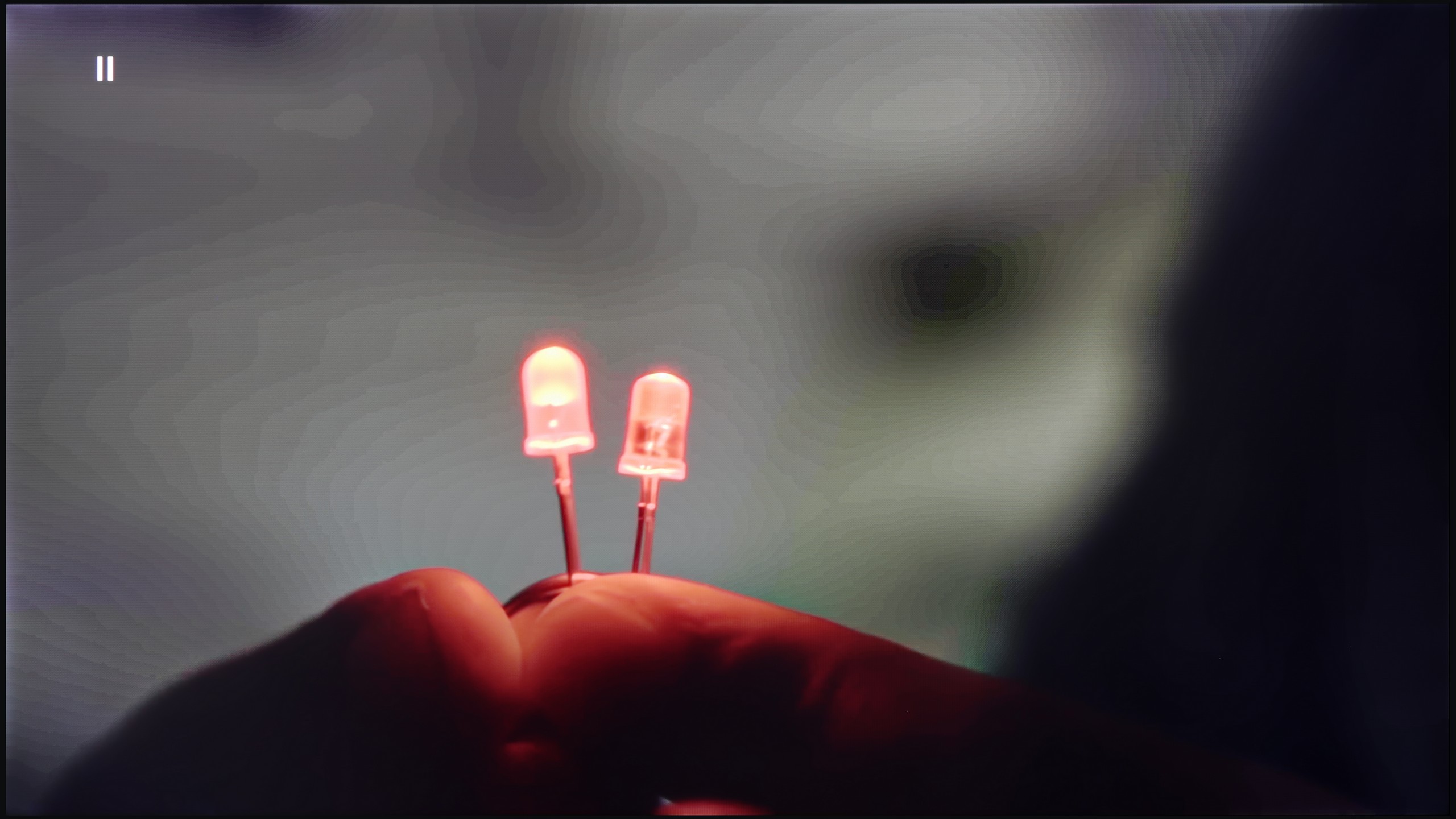
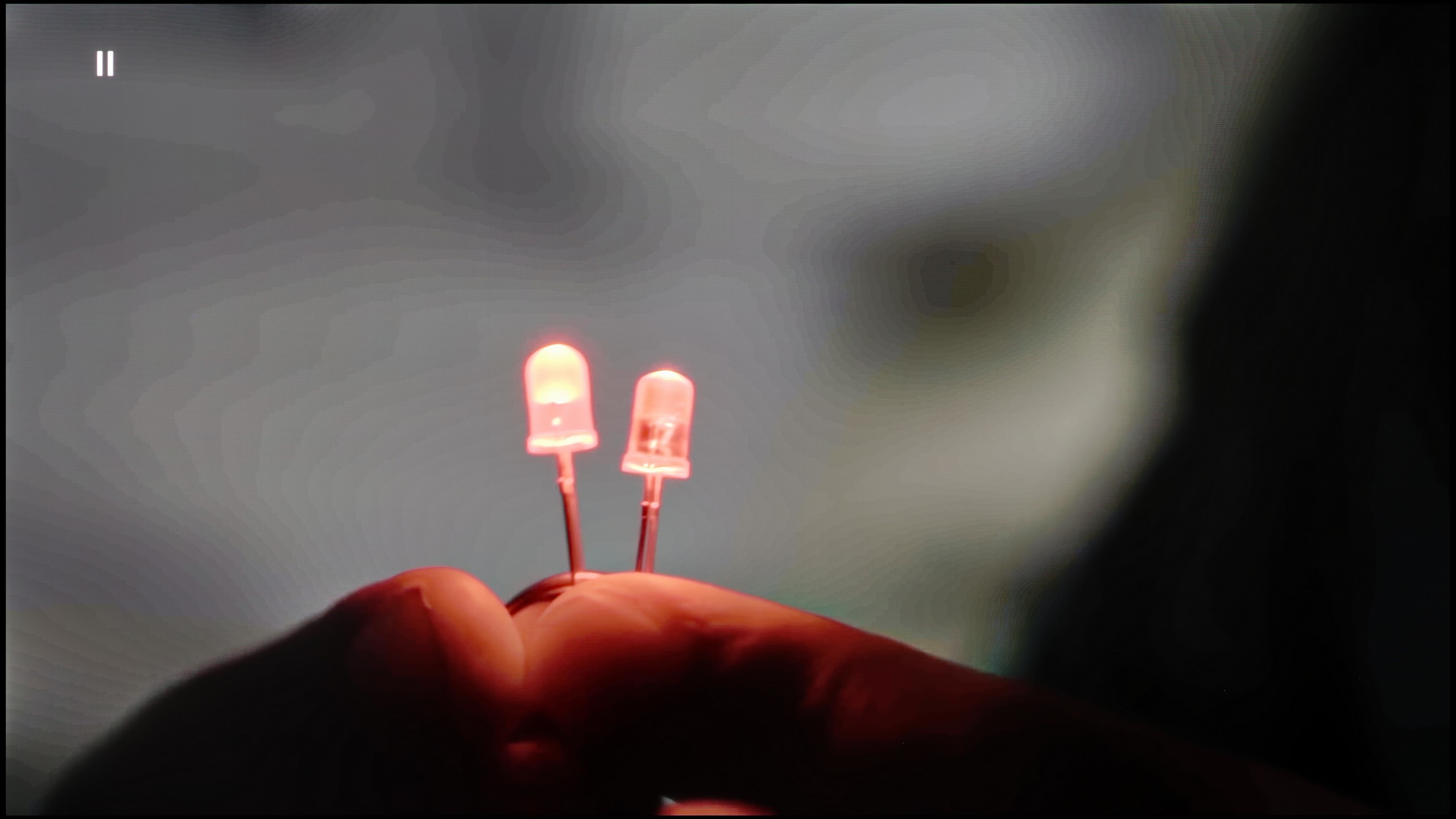
Image without overscan on the SD signal
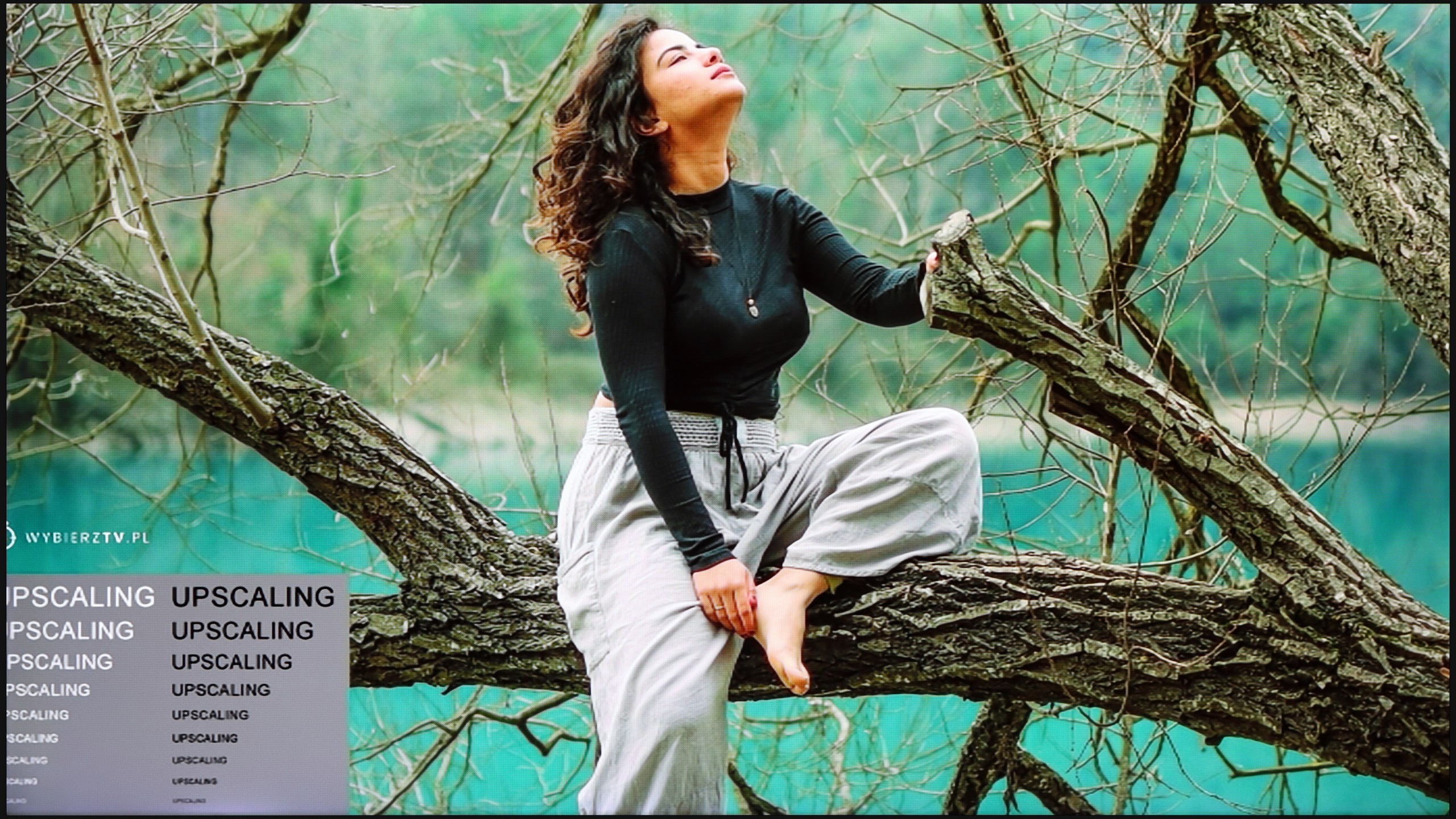

LS03F is equipped with an NQ4 processor, which is responsible for improving image quality – especially in lower-quality materials. In practice, it works surprisingly well, particularly when it comes to older content and recordings with lower resolution. Activating the "noise reduction" feature delivers noticeable results. The television effectively smooths tonal transitions and removes digital noise that can appear in darker areas of the image. Compared to previous generations, there is a clear improvement – earlier, this feature often smoothed everything too much, including details that it shouldn't have removed. In this year’s model, the smoothing still occurs, but it happens in a much more acceptable way. Textures of materials, skin, or fabric details are not as heavily muted as before – the image retains more naturalness. However, this does not change the fact that film grain is still removed by the television, which may not appeal to everyone. On the other hand, it's no longer such an aggressive intervention as in previous models. It's also worth mentioning that the LS03F may struggle with very weak signals – for example, from VHS tapes or low-resolution video. In such cases, we noticed slight clipping of the image at the edges – the so-called overscan. This can lead to situations where a small part of the image (e.g., subtitles at the bottom edge) gets cut off.
The tone transition smoothing function in the S85F works really effectively – it can completely eliminate the problem of visible banding in very poor quality material, such as from YouTube. Unfortunately, even the lowest level of this option comes with compromises. The noise reduction is so aggressive that it can smooth out film grain, which many of us consider to be an element of the cinematic atmosphere. At the “Standard” level, we didn’t notice this function removing anything significant from the image, so we can recommend this setting. On the other hand, the “High” level is a different story – it can smooth out not just noise, but also small, desirable details like, for example, the texture of objects.
When it comes to image scaling, the S85F performs very well. The material looks sharp, and the only slight imperfection is the barely noticeable aliasing of edges. And there’s the ongoing issue with Samsung televisions – overscan. This can cause some scenes to be slightly cropped, which is worth noting when watching very old content.
Blur and motion smoothness
6.9/10
8.5/10
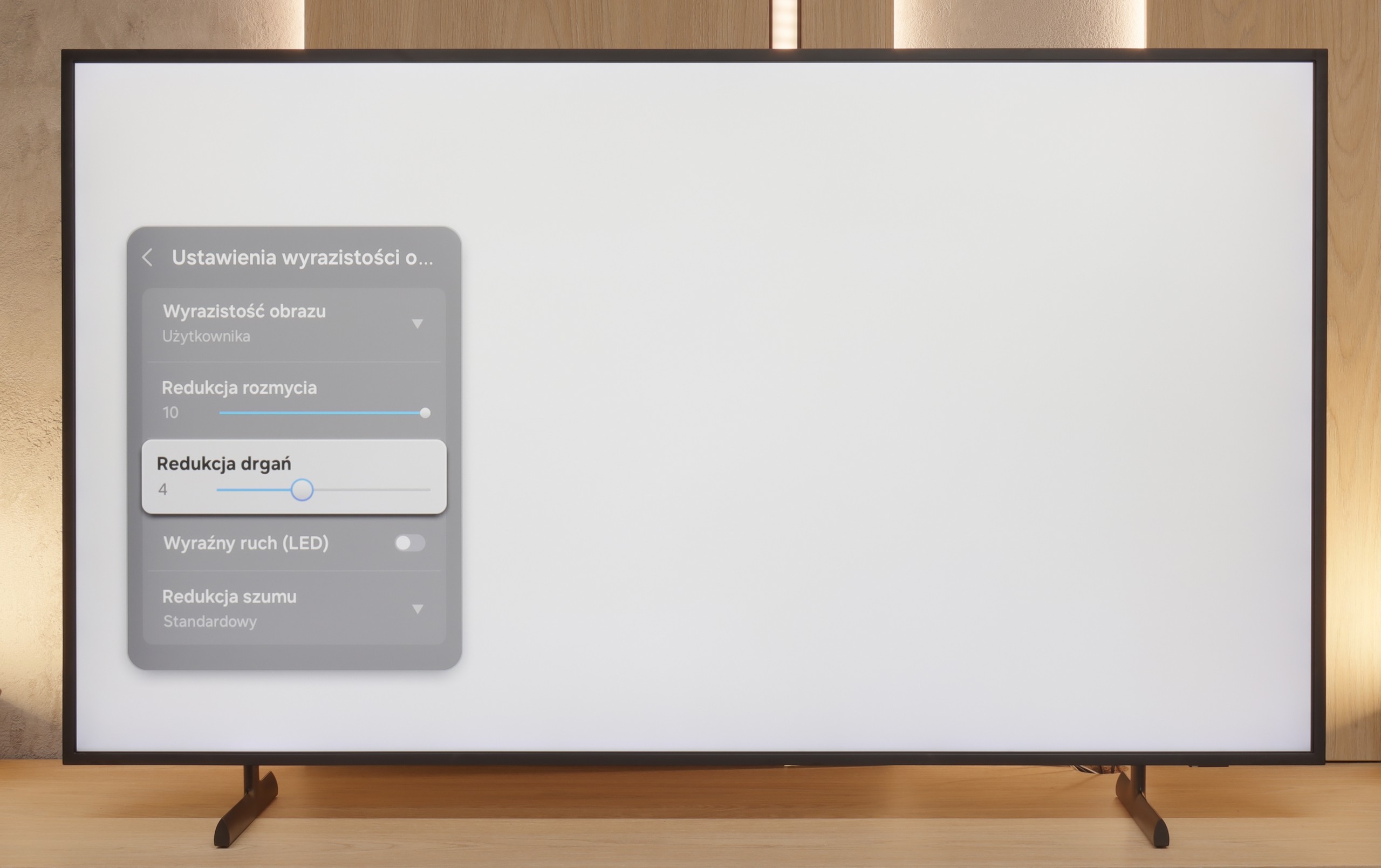
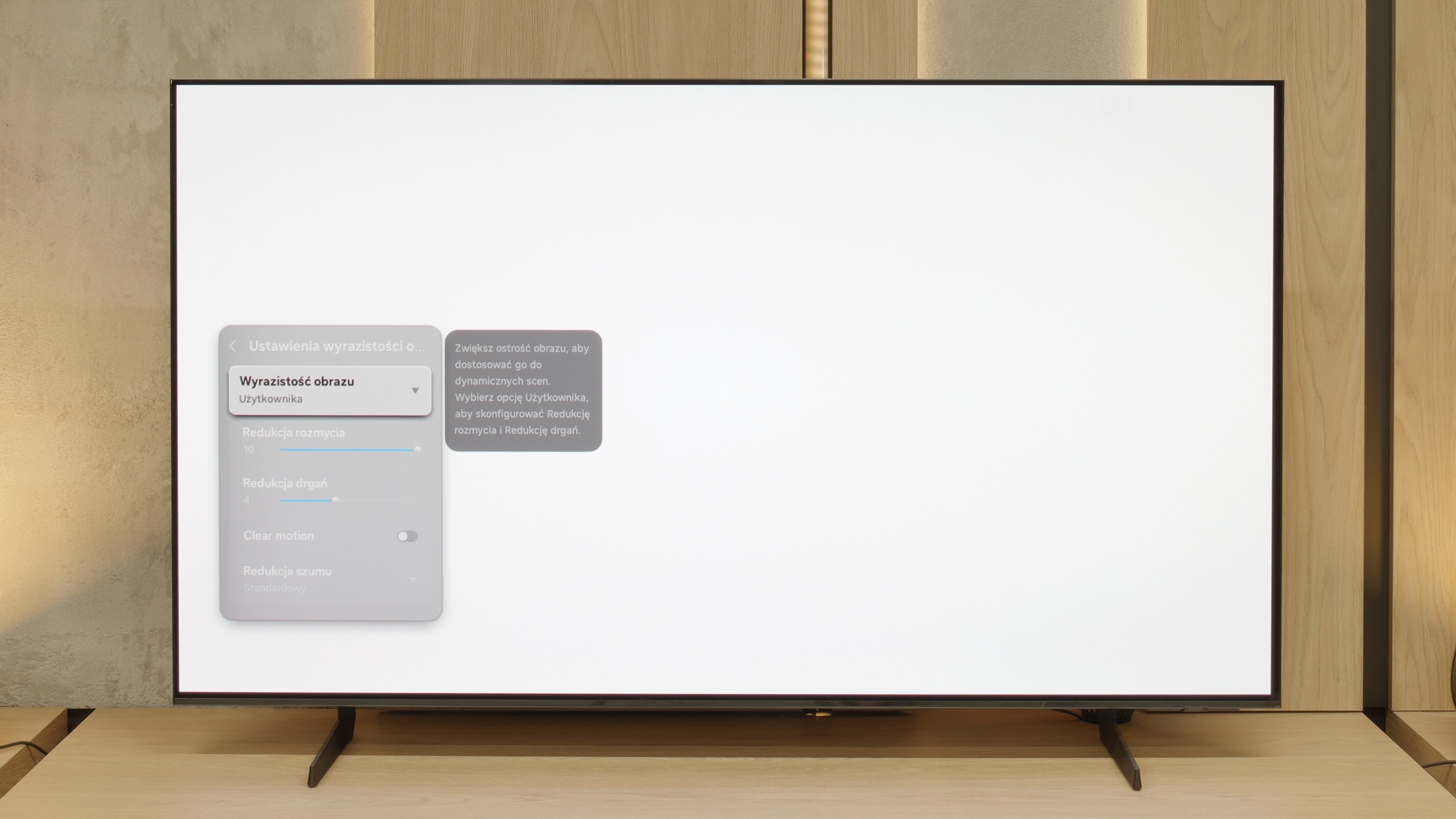
Blur (native resolution, maximum refresh rate):






Blur (BFI function enabled):
Image flickers in this mode



Image flickers in this mode



Smużenie ():
Smużenie (4K@60Hz Game Motion Plus):



The new feature in The Frame for 2025 is a 144 Hz refresh rate display. Yes – in a television primarily associated with displaying works of art, you can now not only watch Van Gogh, but also comfortably play on a console or follow fast-paced sporting events. This is a significant step towards greater versatility. In the case of Samsung movies, as usual in models with a 120 Hz display and above, it allows you to adjust motion fluidity according to your preferences. You can set a more cinematic reproduction that maintains frame rate or opt for complete image smoothing. The range of options is broad, allowing you to tailor the effect to your tastes – regardless of whether the screening is meant to look like classic cinema or a performance on a modern theatre panel.
*this part of the test refers to the model LS03FAU in sizes 55 and 65 inches, which is equipped with a 144Hz display; the sizes 43 and 50 inches have 60Hz displays, and consequently perform much worse in terms of motion fluidity.
S85F is an incredibly fast television – and that’s not just empty hype. Thanks to the 120 Hz OLED panel, dynamic scenes, whether in games or while watching a live match, look just as they should – smooth, sharp, and without the feeling that something is "slipping" out of frame. The lightning-fast pixel response time, typical of OLEDs, plays a big role here. Transitions between frames are virtually instantaneous, and the image remains clear even during the fastest camera movements. A ball flying across half the field? A car speeding in a chase scene? Everything here is clear and free of the typical "trail" associated with LCDs.
This is exactly what we expect from a good OLED – zero compromises when it comes to motion smoothness. The S85F gives the impression that regardless of the pace of action, we can focus on what’s happening on the screen, rather than on the imperfections of the image.
Console compatibility and gaming features
8.1/10
8.2/10
- ALLM
- VRR
- VRR range48 - 144Hz48 - 120Hz
- Dolby Vision Game Mode
- Correct implementation of HGIG
- 1080p@120Hz
- 1440p@120Hz
- 4K@120Hz
- Game bar
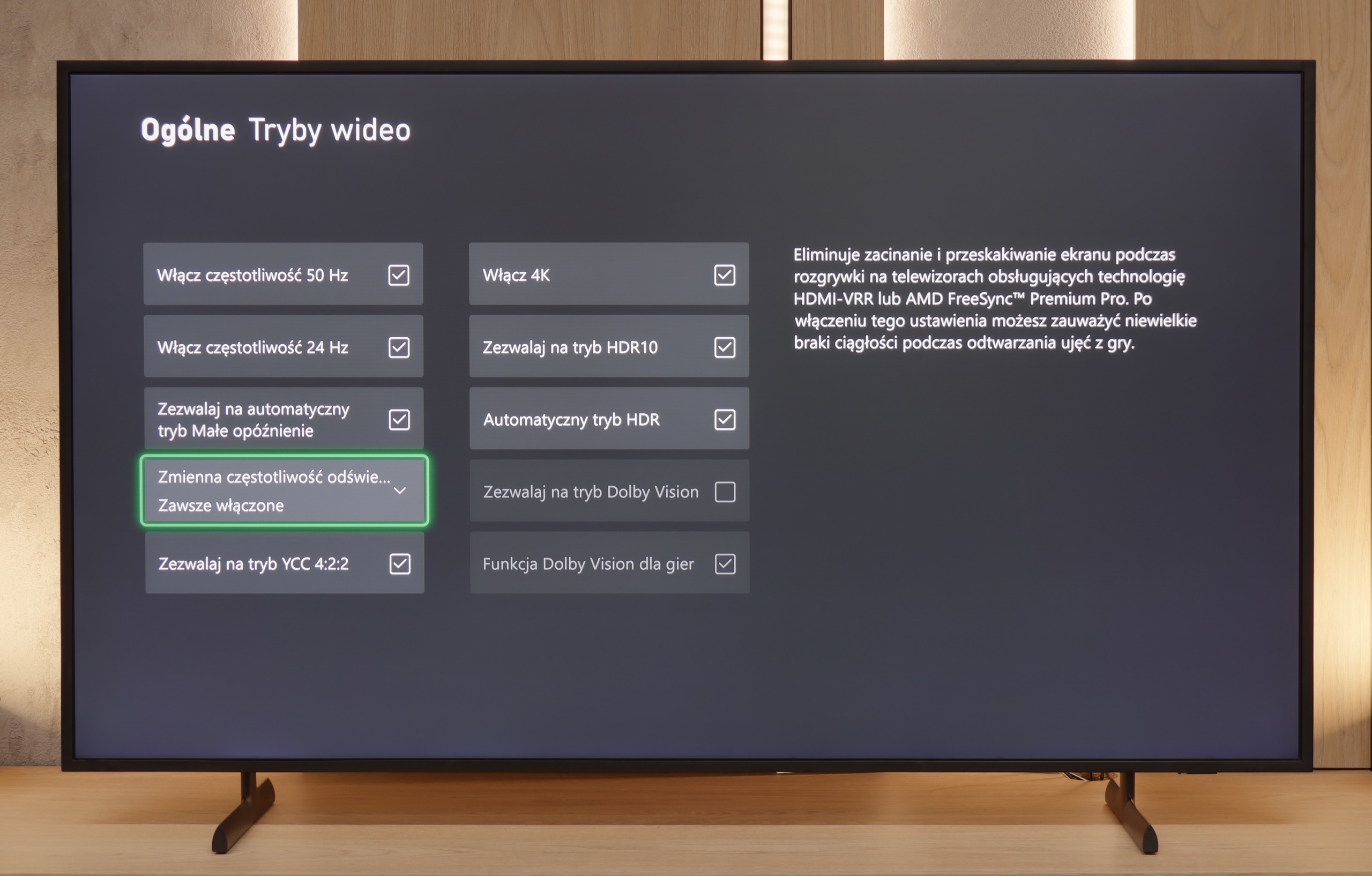
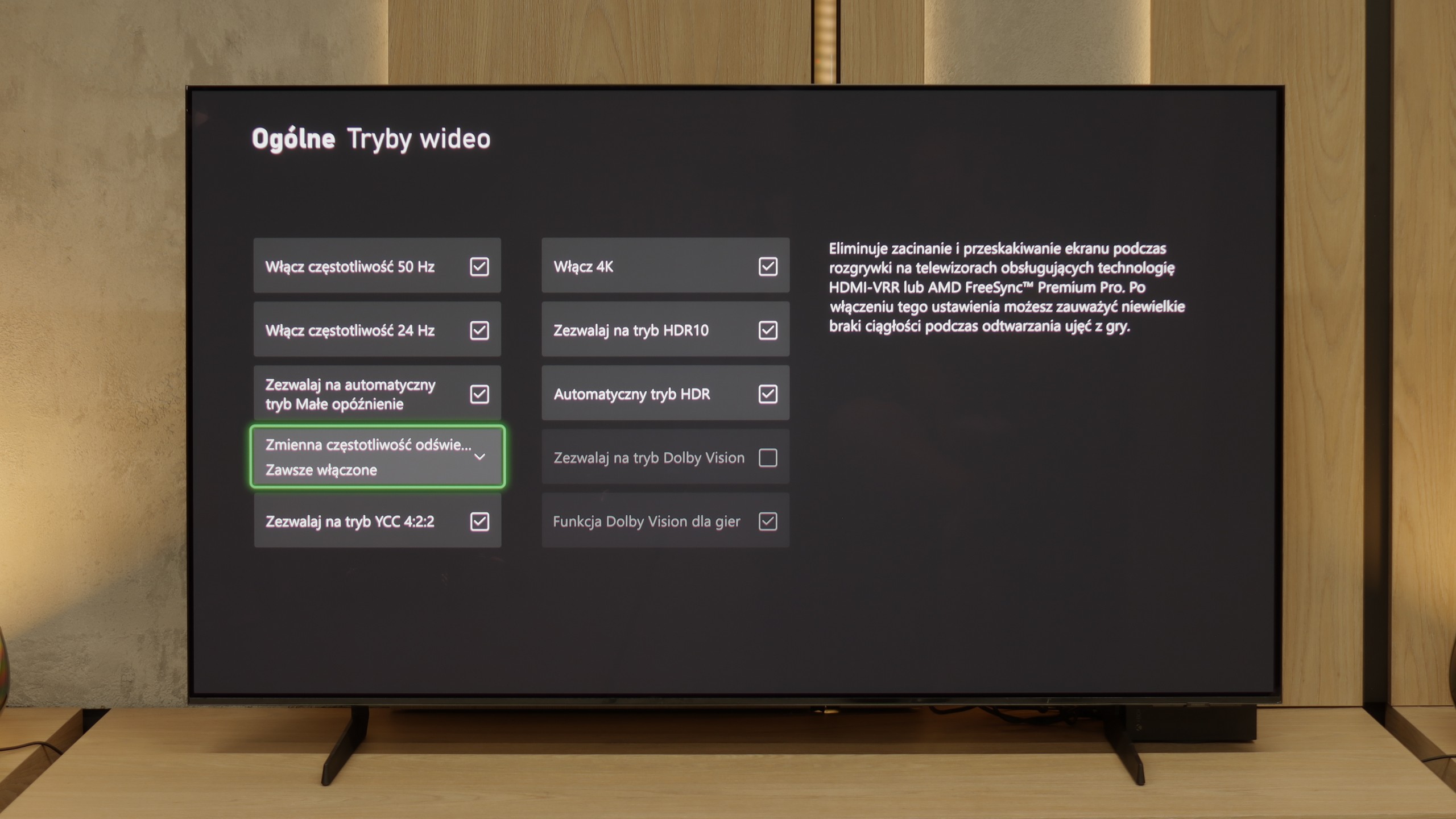
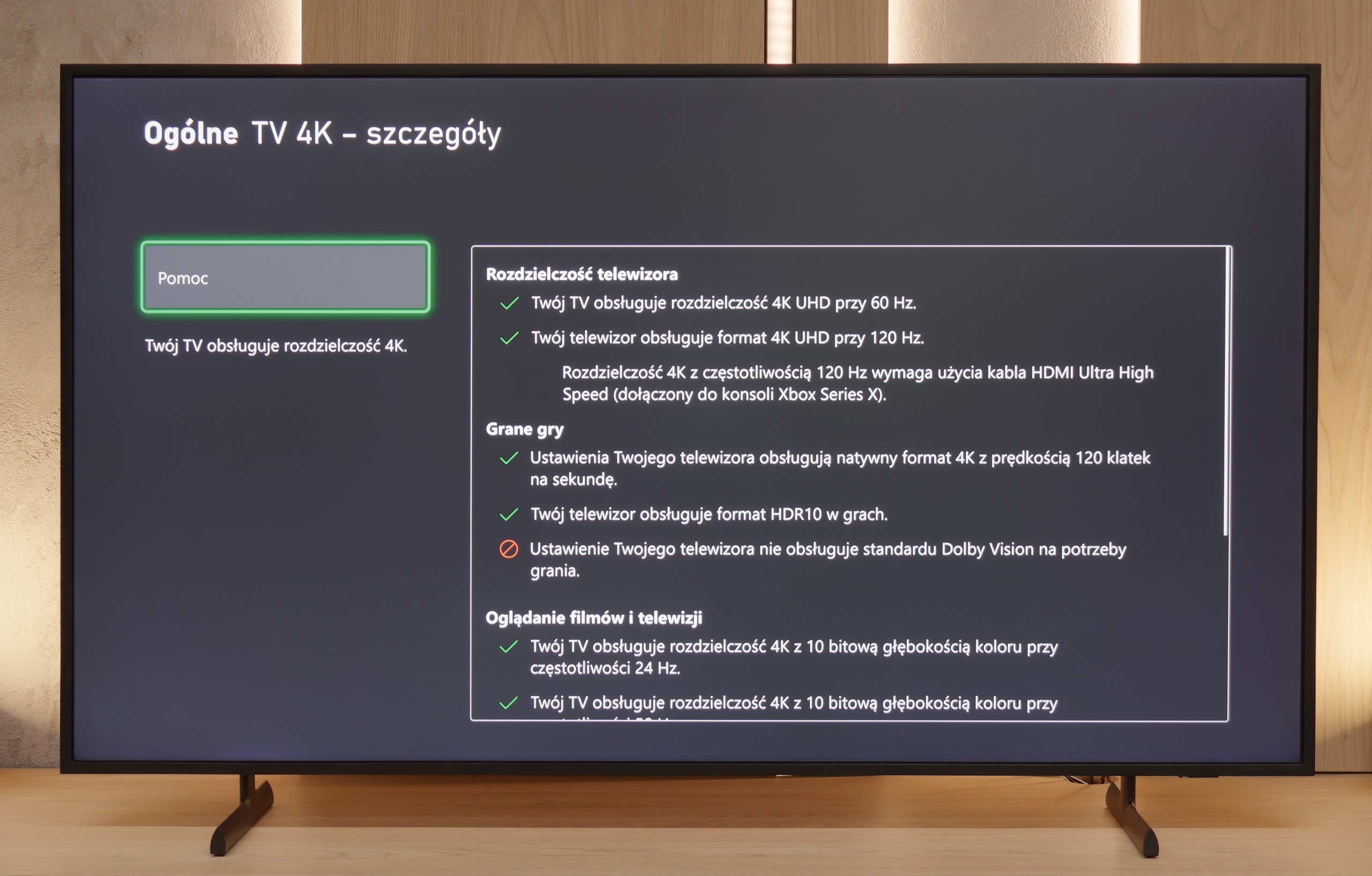
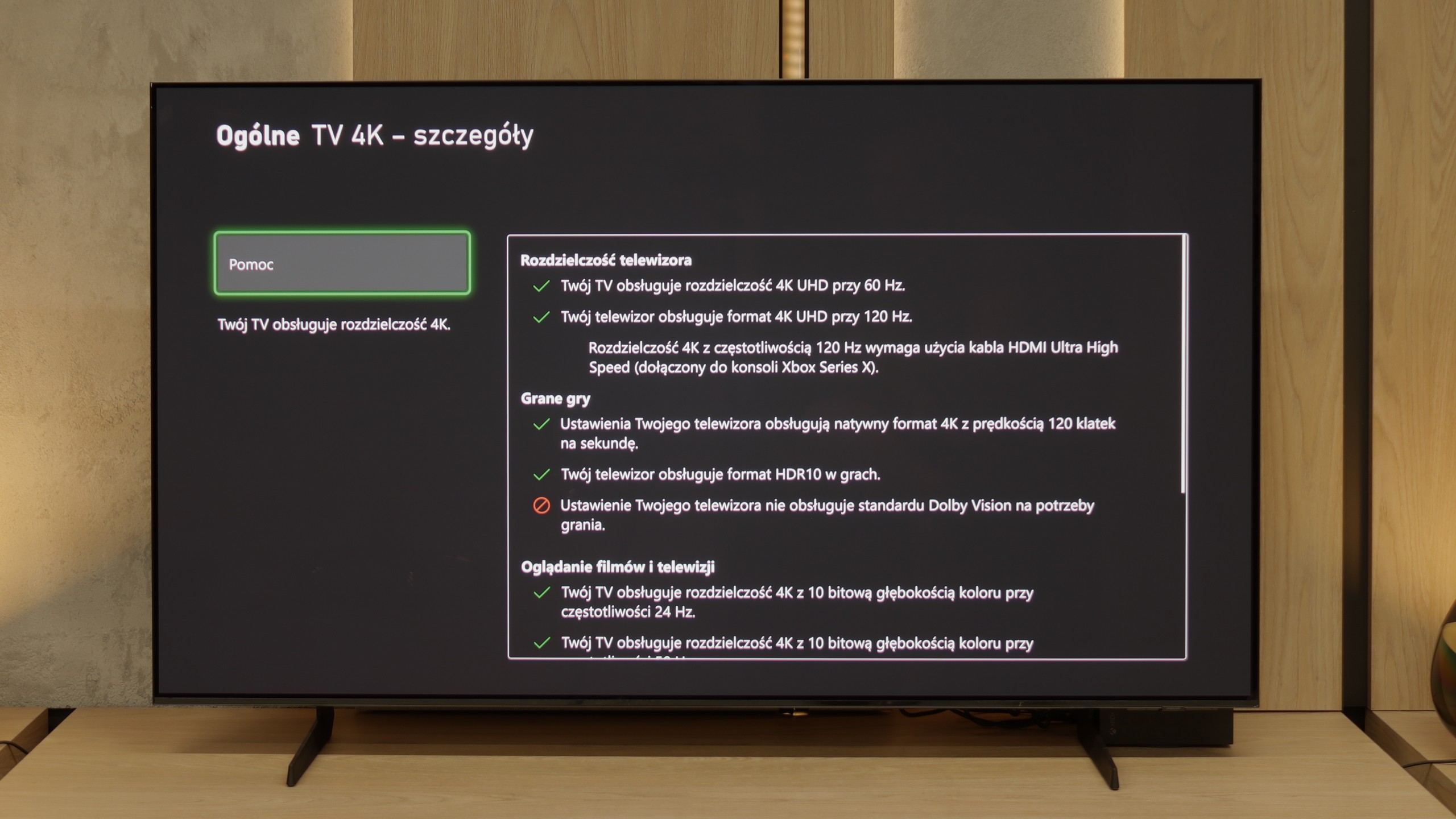

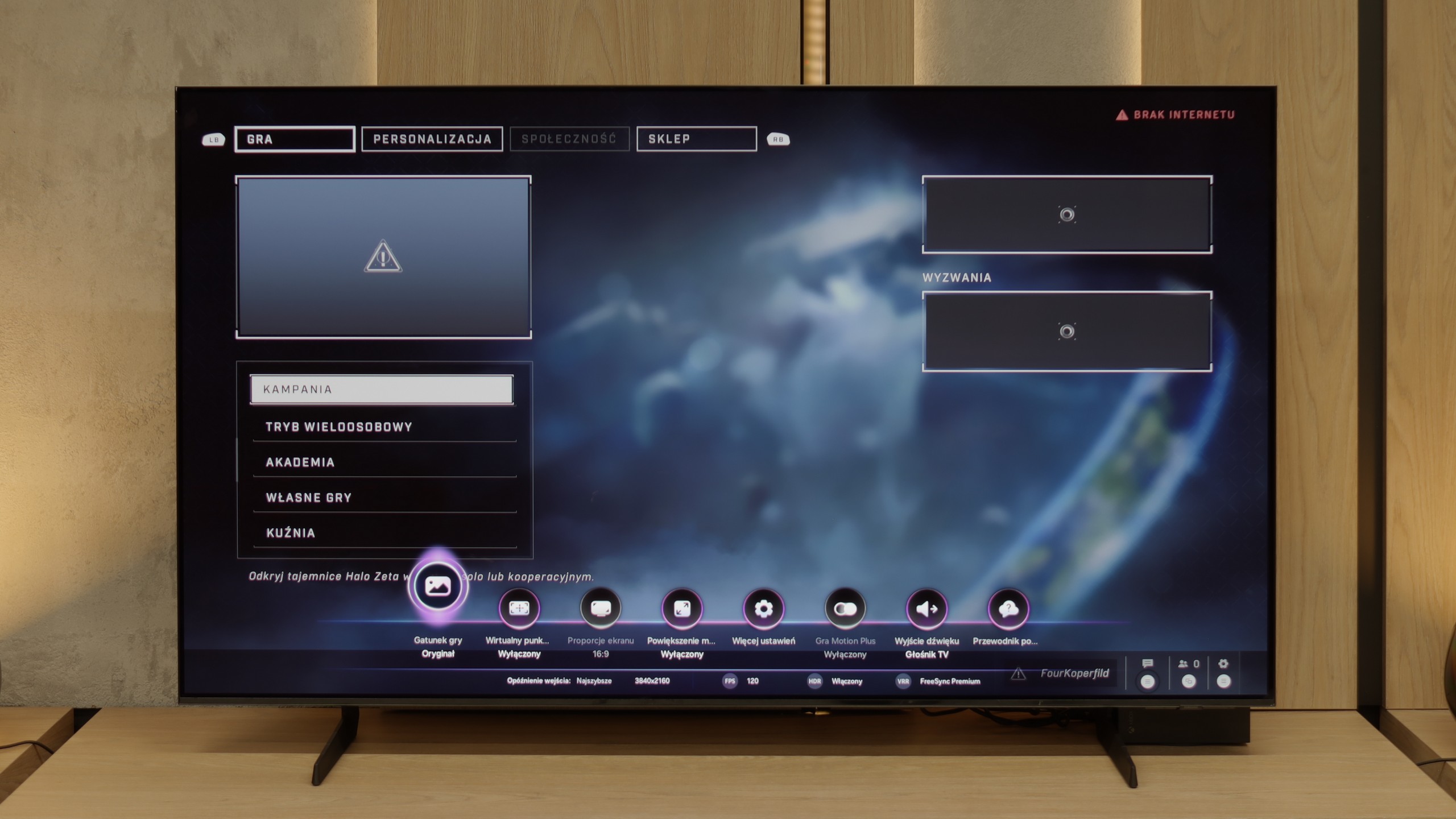
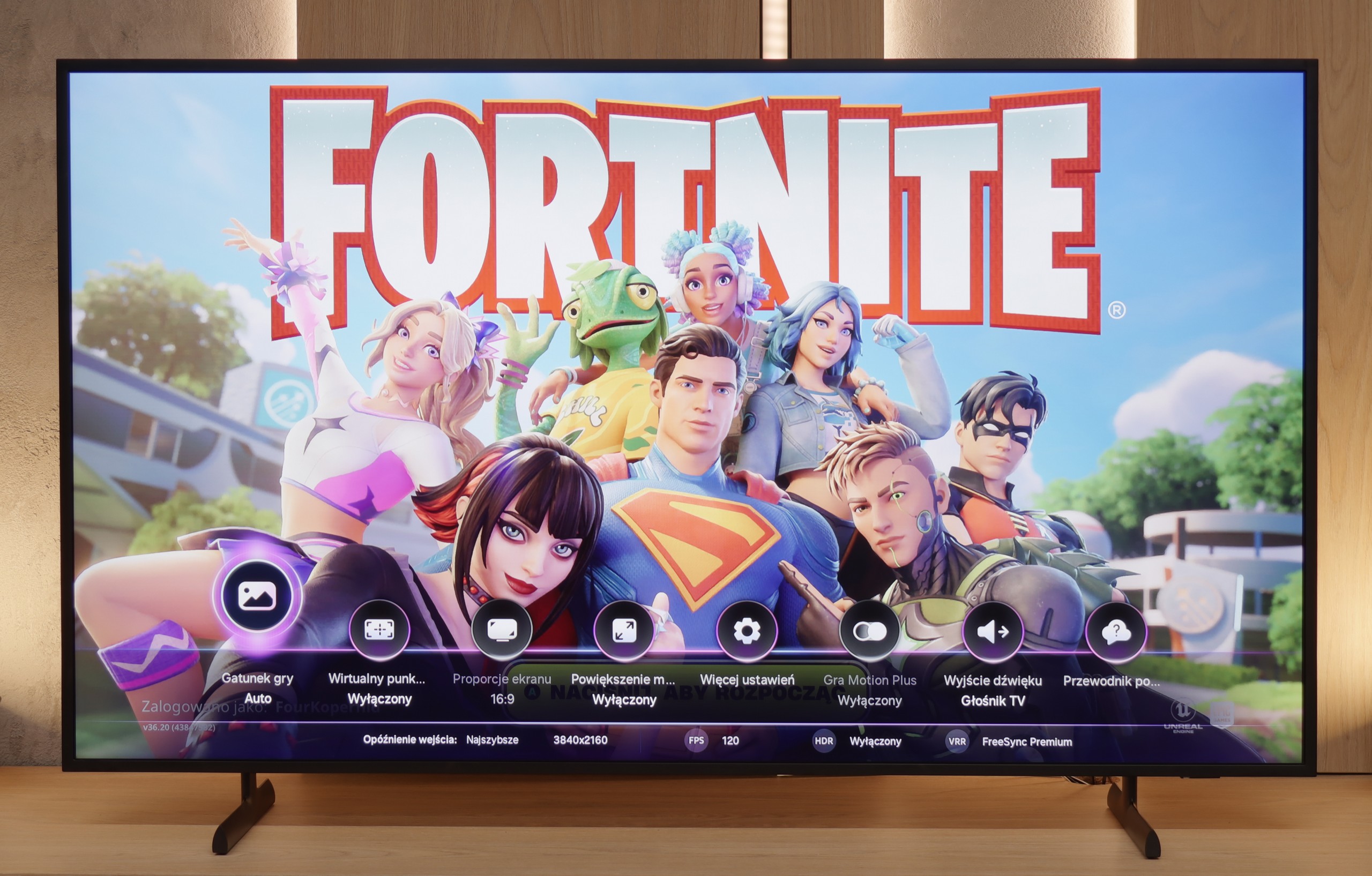
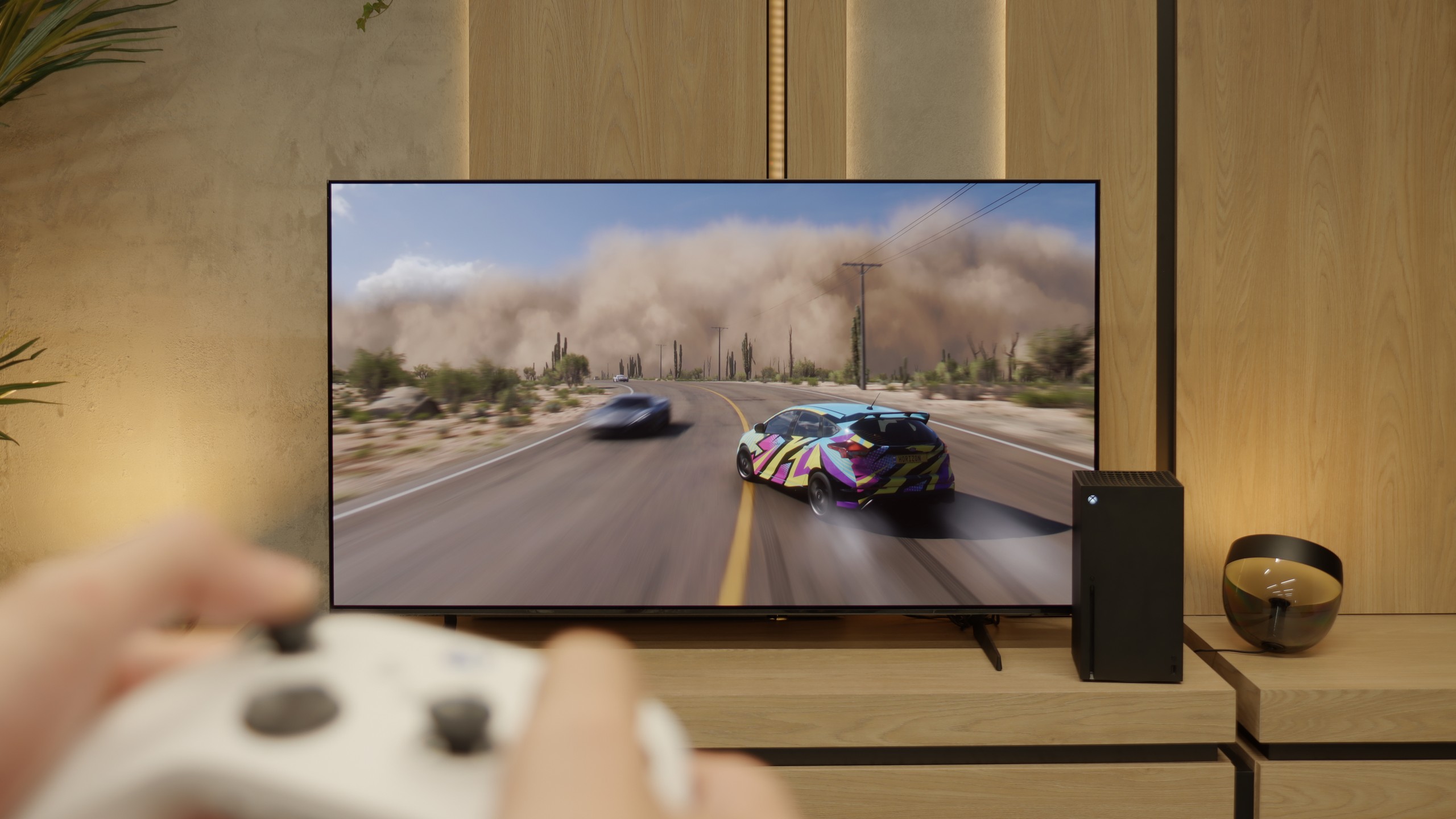
As we mentioned earlier – although The Frame likely displays images and artwork for most of the time, Samsung recognised that a Van Gogh fan could just as easily be an avid gamer. And it must be said that The Frame 2025 has almost everything to become a fully-fledged gaming TV.
Onboard, we find support for ALLM (Auto Low Latency Mode) and Variable Refresh Rate (VRR) thanks to the implementation of a single HDMI 2.1 port. The TV handles lower resolutions at higher refresh rates effortlessly and features an expanded Game Bar – already known from other Samsung models – which allows for quick preview and adjustment of key gaming-related settings. For this, it gets extra points from us. Noteworthy is also the proprietary motion smoother, Auto Motion Plus Game, which – and this is worth emphasising – works without increasing input lag. Samsung remains the only manufacturer that has managed to implement this feature in a practically unnoticeable way regarding delays. The result? Much better fluidity in games, especially those that struggle to maintain a stable 60 frames. This solution can genuinely improve gaming comfort in more demanding titles – particularly on consoles that don’t always manage full fluidity, especially in AAA games.
As for the downsides – the lack of Dolby Vision is already something we consider standard in Samsung TVs, so there’s not much to specifically nitpick here. However, the problem lies elsewhere. In the latest version of the Tizen system, the HGiG option has disappeared. Literally – it’s gone. This is a significant inconvenience when configuring the console for proper HDR content display in games. It's hard to understand why such a decision was made, but one thing is certain – this needs to be fixed as soon as possible. We’re talking about a brand that has set standards for gaming on TVs for years. If HGiG returns – and we hope it does – The Frame LS03F can confidently aspire to be a proper gaming TV. Not only as a decoration on the wall, but as equipment that truly enhances the gaming experience.
S85F has practically everything on board to become the dream screen for gaming. Four full HDMI 2.1 ports with a bandwidth of 48 Gb/s, support for VRR, ALLM, a super-detailed Game Bar that clearly shows all parameters – plus a gem in the form of Game Motion Plus. This motion smoother makes animation in games more enjoyable, while input lag increases slightly. It's a rare combination, and that’s a big plus for Samsung.
Perhaps Samsung will fix this in the next update – and we have high hopes for that. Because if HGiG comes back, the S85F will become nearly the perfect TV for gamers.
Input lag
10/10
10/10
SDR
HDR
Dolby Vision
When it comes to input lag, Samsung maintains a very high standard. The LS03F, like most of this year's models from the brand, achieves a score of 8 ms for 4K content, which is practically a benchmark value. This result allows you to play even the most dynamic titles without delays and with complete responsiveness. Well done!
Here, dear gamers, the S85F shows its claws. 5 ms with 120 Hz content and around 10 ms with 60 Hz are results that can be described in one word in the world of televisions – phenomenal. This means that the response to our movements is practically instantaneous. We press the button, and the action on the screen happens without any delay, as if the television can read our thoughts. In dynamic games, where a fraction of a second can decide victory or defeat, such values make a huge difference. There's no question of a nervous "wait" for the image to catch up with our movements. The S85F gives us the feeling that everything is under our complete control – and that's how it should be in equipment that aspires to be the ideal screen for a gamer.
Compatibility with PC
8.2/10
7.6/10

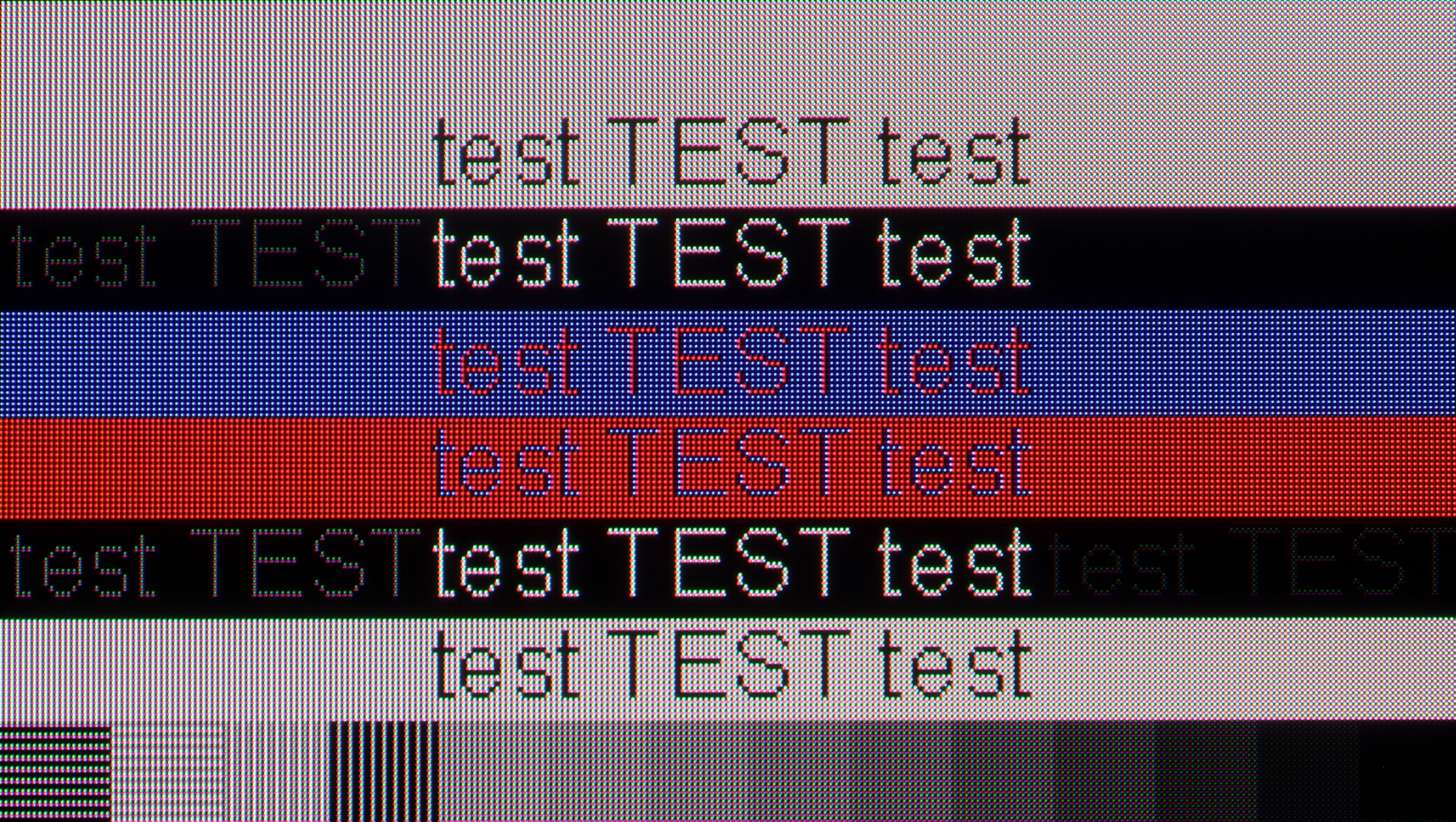
Collaboration of The Frame 2025 with a computer poses no major issues. Let's start with gaming, as this is where this model shows its strengths – support for 144 Hz signal, low input lag, and compatibility with G-Sync technology (for NVIDIA cards) make it hard not to consider it a full-fledged gaming monitor. It’s one of the more interesting "gaming with PC" televisions available on the market in this class.
When it comes to everyday work, the situation looks just as good. The Frame easily handles chroma 4:4:4, which translates to good font readability and overall user comfort. We only noticed slight issues with dimming very thin lines and dark details on a light background – this effect may occur, particularly when working with small interface elements. In practice, however, with a 55-inch screen and standard office working distances, it will be hard to realistically notice this problem. Nonetheless, it's worth keeping this in mind if the television is to serve as a monitor not only for entertainment but also for precise graphic or text work.
If you're planning to connect the S85F to a computer, we have good news – this television is perfect for that. Low input lag and a 120 Hz panel make gaming on PC a pure pleasure. Whether we're talking about dynamic shooters or more relaxed RPGs, the response is instantaneous, and the smoothness of the animation can draw you in for hours on end.
Of course, there’s no rose without thorns. Due to the diamond pixel layout in the QD-OLED panel, there is a slight "rainbow icon" effect, particularly noticeable when sitting close to the screen. Fortunately, this is more of a detail that most of you won’t mind in everyday use. Especially since, thanks to the proper implementation of 4:4:4 chroma, the readability of fonts is at a very good level – documents, websites, and text editors simply look as they should.
Viewing angles
3.5/10
9.8/10
As one could expect from a VA panel, the viewing angles on The Frame 2025 are at best mediocre. The image loses saturation and contrast when viewed off-axis. It's a shame, because we're talking about a model that displays digital artworks in standby mode – and it's precisely in such moments that wide viewing angles would make the most sense, enhancing the feeling of interacting with a real piece of art rather than just its screen imitation.
Perhaps in the future, manufacturers will decide to introduce special coatings or modified versions of VA panels that improve this aspect – as it would have real significance not only in terms of functionality but also aesthetics for lifestyle televisions.
Here, dear readers, the S85F reaches the absolute peak. The viewing angles are phenomenal – some of the best you can get in a TV today, and it’s thanks to the unique QD-OLED panel from Samsung Display. Of course, WOLED panels can also maintain a high level in this regard, but let’s not kid ourselves – what the QD-OLED shows in the S85F is even more impressive. Colours, contrast, and brightness remain practically unchanged even when viewing the screen from a very large angle. It’s the kind of television where you don’t have to fight for the “best spot on the couch” – everyone will see the picture in all its glory, no matter where they’re sitting.
TV efficiency during daytime
6.3/10
5.1/10
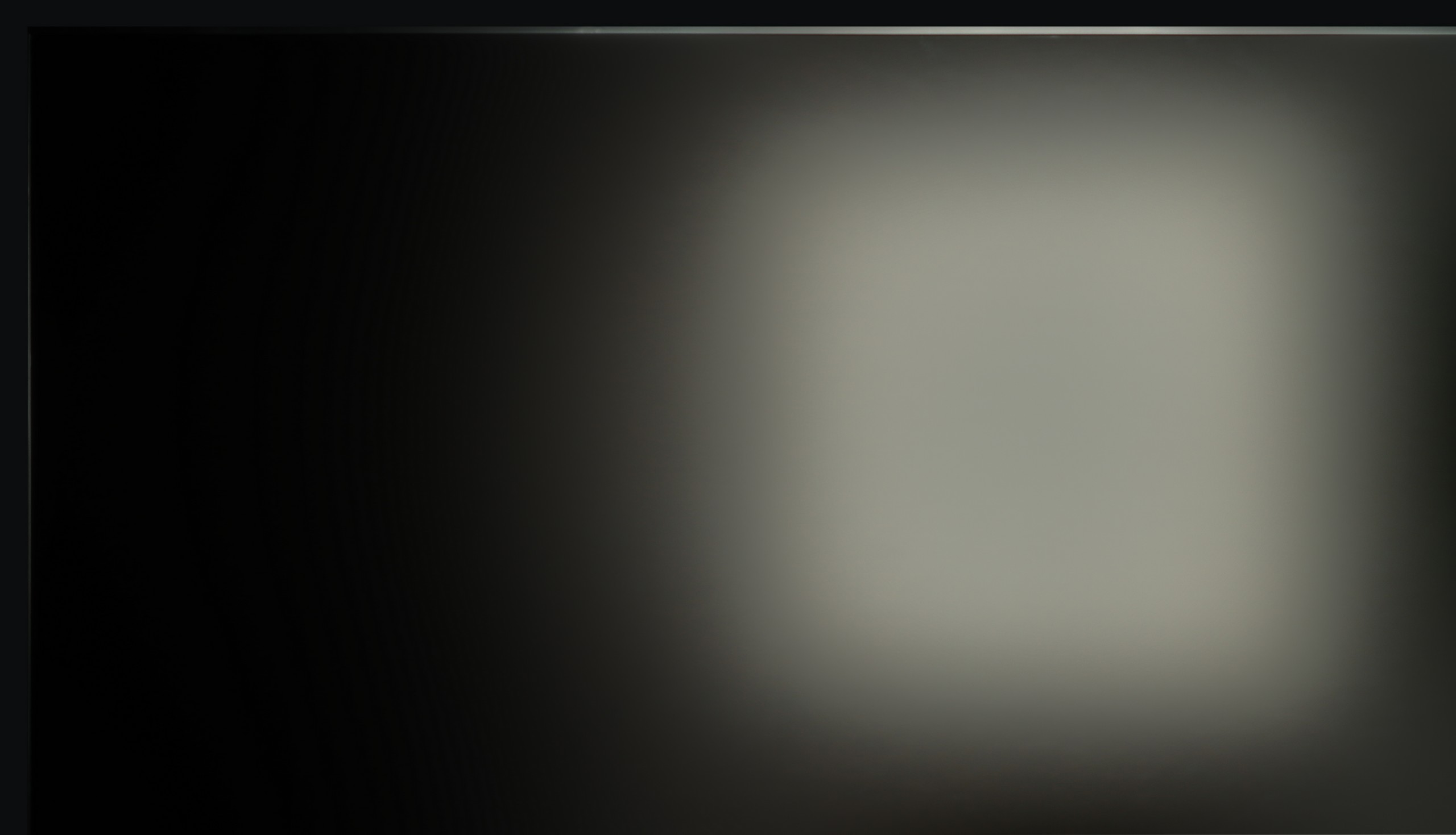
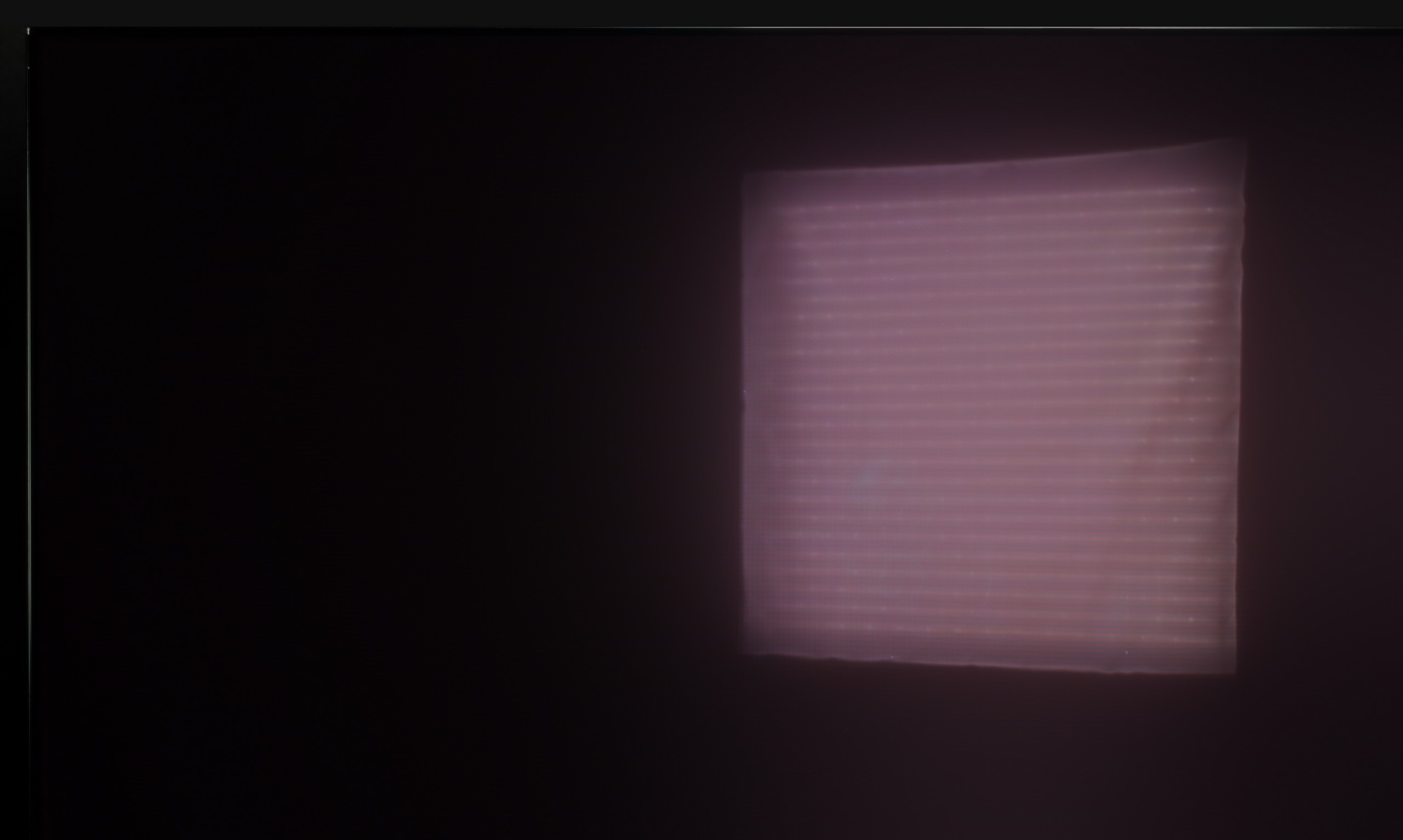


Matrix brightness
Average luminance SDR
Samsung S85F OLED: 317 cd/m2
Samsung The Frame 2025 (LS03F): 596 cd/m2
One of the most distinctive features of The Frame is its matte display – and it must be said that Samsung has really perfected this aspect. From our experience, it's one of the best solutions for reducing reflections, especially direct ones. If reflections on the screen can be irritating, it will be hard to find a better screen in this budget than the matte panel used in Samsung TVs. Of course, this comes with a certain compromise. In very bright sunlight, colours may appear slightly faded, and the image loses a bit of depth. However, this is something we consciously accept when opting for a matte screen – you win some, you lose some. In practice, the colours and contrast on Samsung's matte screen still outperform those on Chinese models such as TCL NXT Vision or Hisense Canvas TV. If effective reduction of reflections is a priority and you want to use the TV also as a “digital artwork” in bright rooms, it’s hard to make a better choice.
The Frame achieves around 600 nits of brightness, which, combined with the matte coating, ensures that the TV performs well in well-lit daytime conditions. It may not be at the level of flagship models, but in everyday use – in a living room with plenty of light – it handles it without any problems.
We really liked the saying "no rose without thorns," and it fits perfectly with QD-OLED TVs. Especially when we look at their performance in highly lit conditions. As you may notice, under very intense light, the surface of the panel can take on a slightly cherry hue. The effect is subtle in the case of the S85F, but in extreme lighting conditions, black can appear a bit worse than in WOLED panels. But – and this "but" is key here – QD-OLED suppresses direct light reflections much better. This means that reflections will be less bothersome, and the picture will retain clarity even when something bright reflects on the screen. You win some, you lose some.
As for brightness, the S85F is a moderately bright OLED. It’s not a model designed for extremely sunny living rooms. If you plan to place it in a very bright room, we recommend considering blinds or placing it in a location that at least partially protects it from direct light.
Details about the matrix
Subpixel Structure:
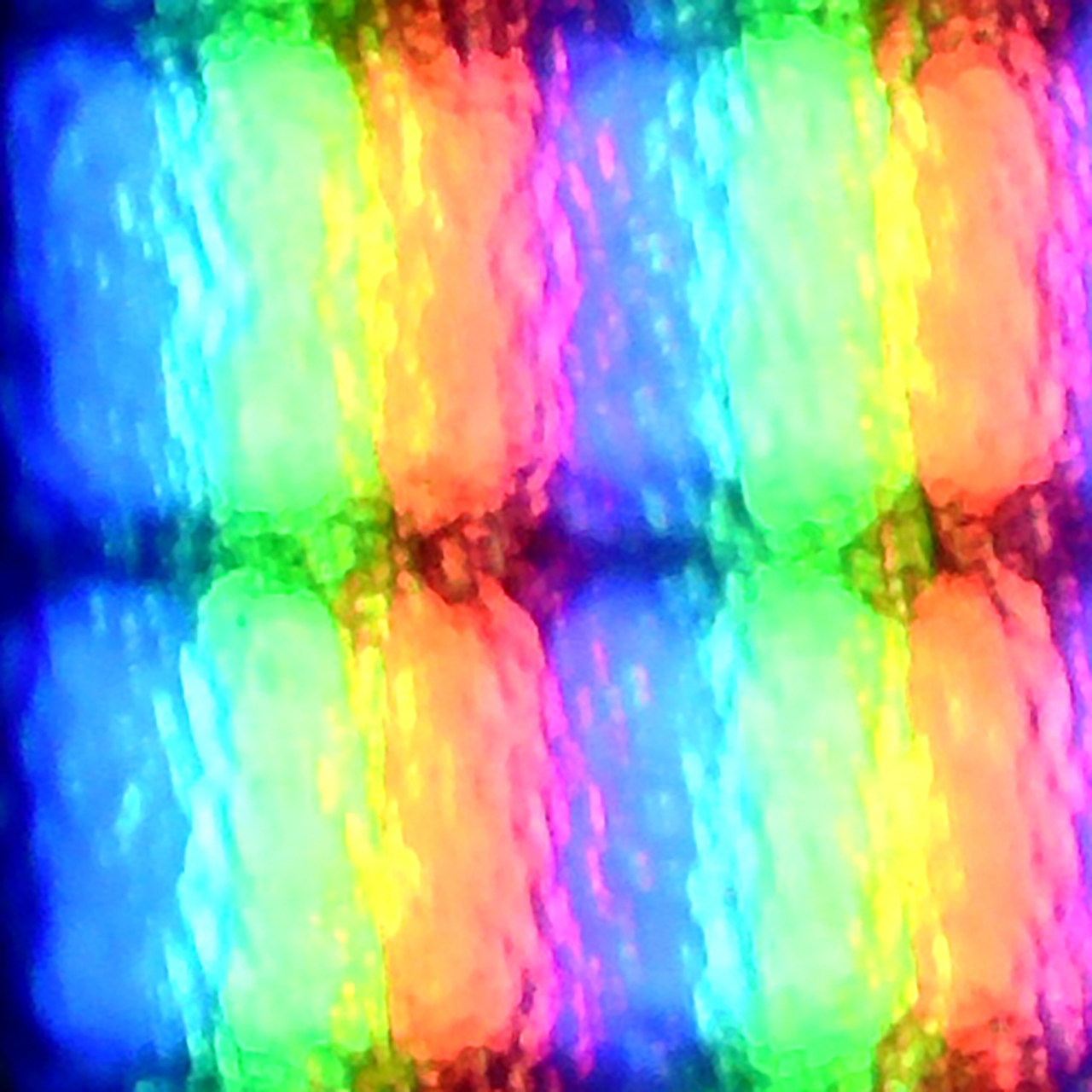

Panel uniformity:
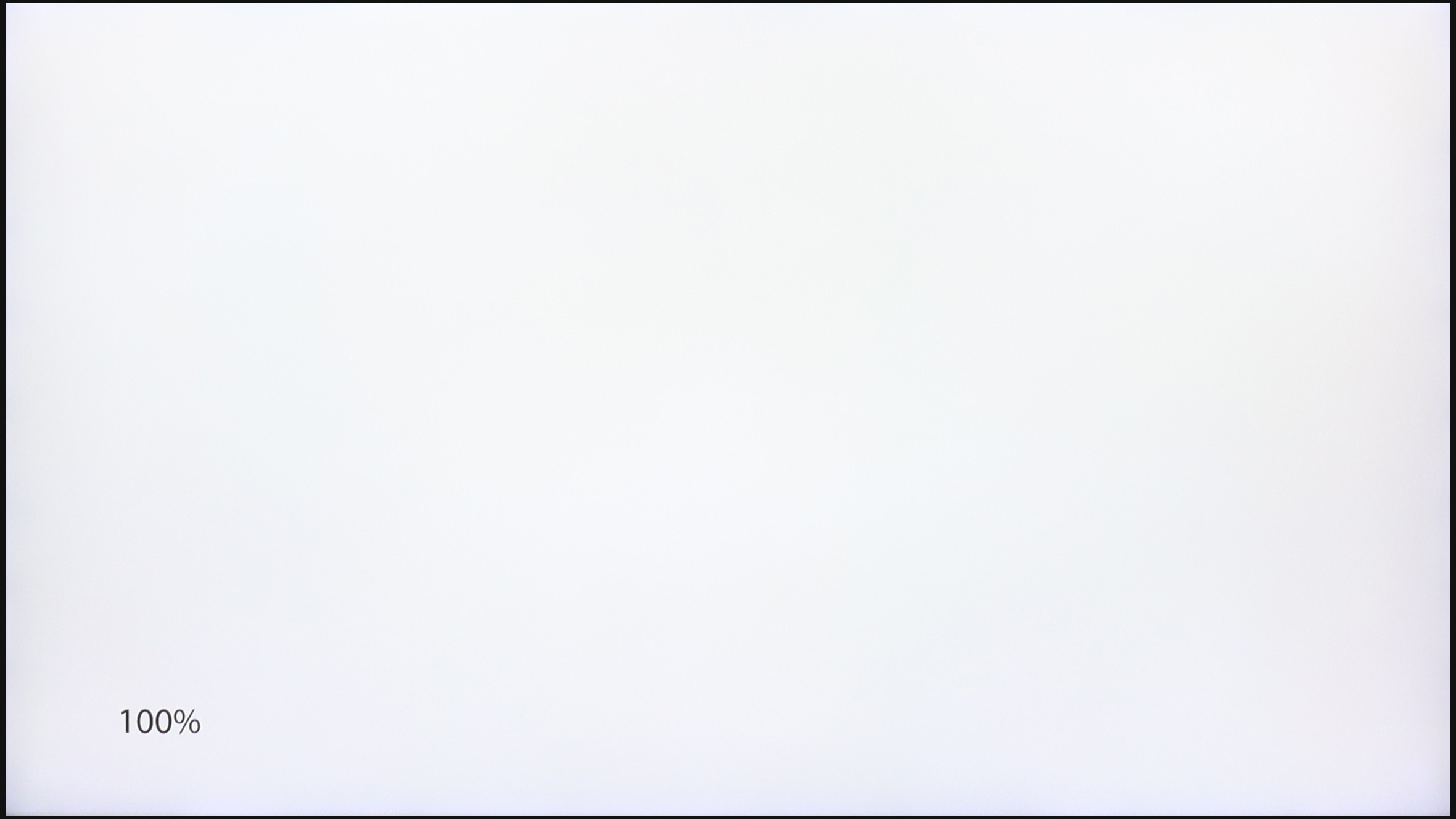

Samsung The Frame 2025 (LS03F)
Samsung S85F OLED
TV features
8.1/10
7.2/10
- HDMI inputs3 x HDMI 2.0, 1 x HDMI 2.1 40Gbps0 x HDMI 2.0, 4 x HDMI 2.1 48Gbps
- Other inputsToslink (Optical audio)
- OutputsToslink (Optical audio), eARC (HDMI), ARC (HDMI)Toslink (Optical audio), eARC (HDMI), ARC (HDMI)
- Network InterfacesWi-Fi 2.4GHz, Wi-Fi 5GHzWi-Fi 2.4GHz, Wi-Fi 5GHz, Ethernet (LAN) 100Mbps
- TV receptionDVB-T, DVB-T2, DVB-S, DVB-S2, DVB-CDVB-T, DVB-T2, DVB-S, DVB-S2, DVB-C
Classic features:
- Recording to USB (terrestrial TV)
- Recording programming
- Picture in Picture (PiP)
- RF remote control (no need to aim at the screen)
- Backlit remote control
- Teletext
- Audio only mode
- Possibility to connect Bluetooth headphones to the TV
- Possibility to simultaneously use Bluetooth headphones and the TV speaker
Smart features:
- AirPlay
- Screen mirroring (Windows Miracast)
- Wyszukiwanie głosowe
- Voice search in native language
- Ability to connect a keyboard and mouse
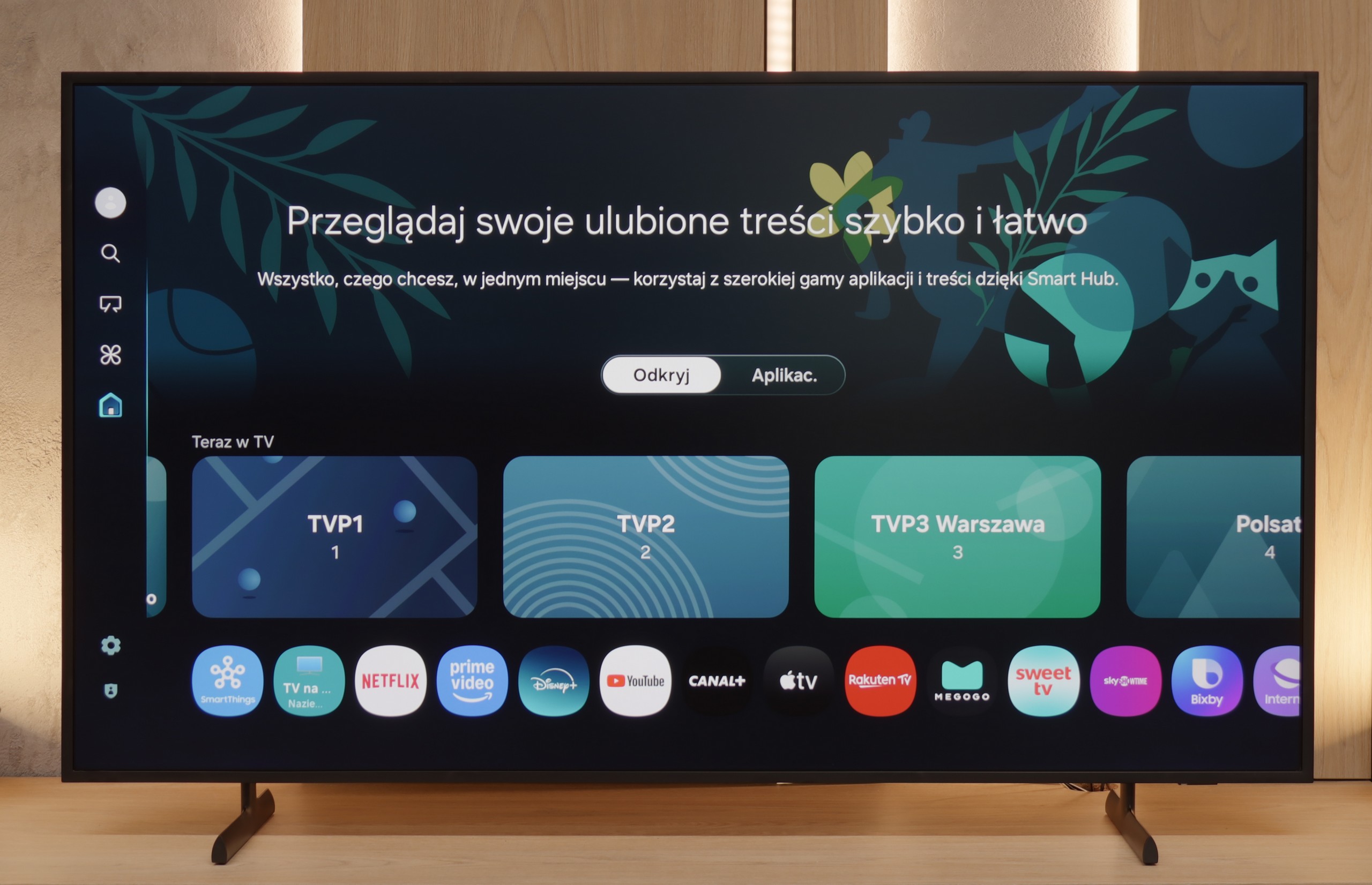
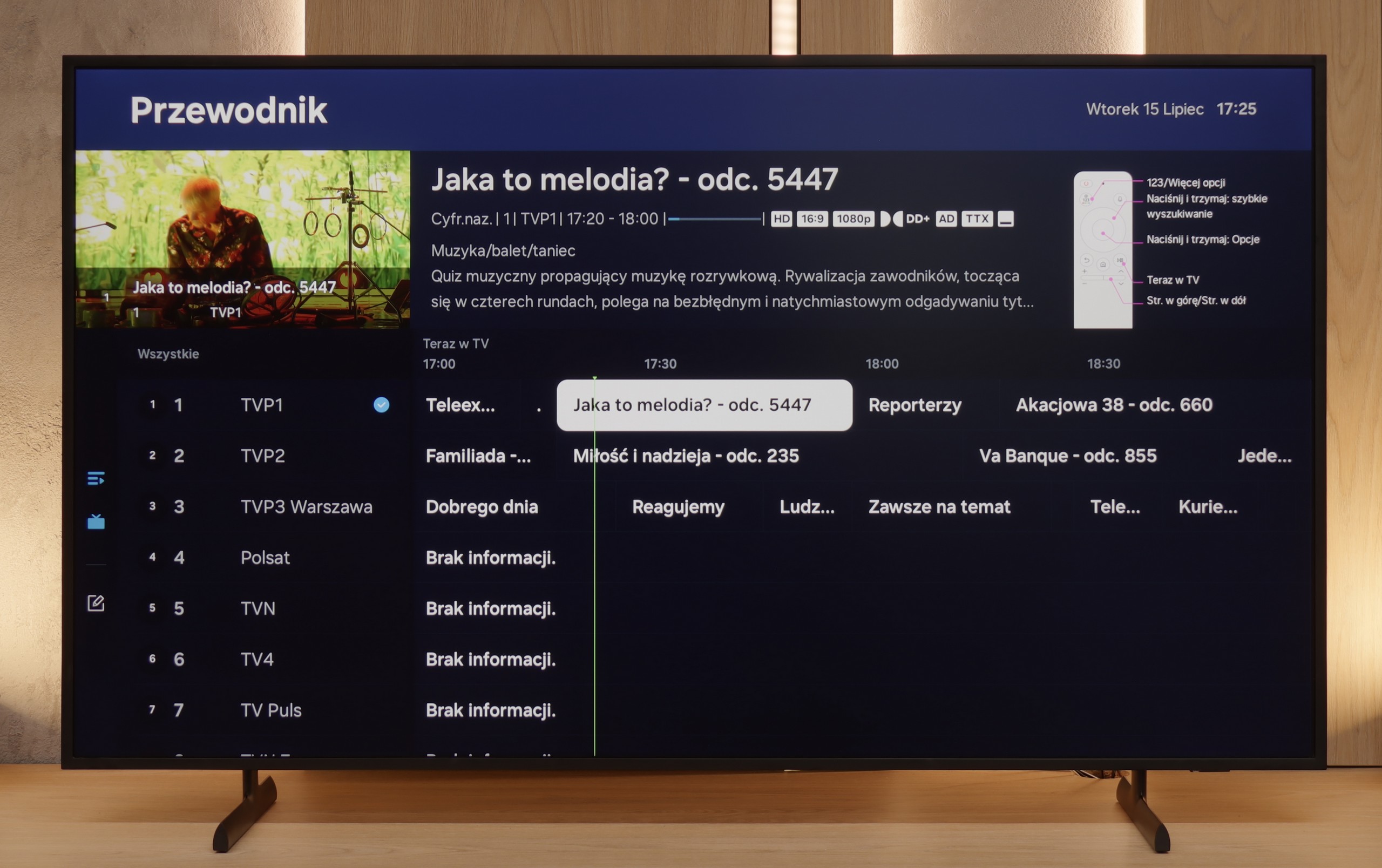

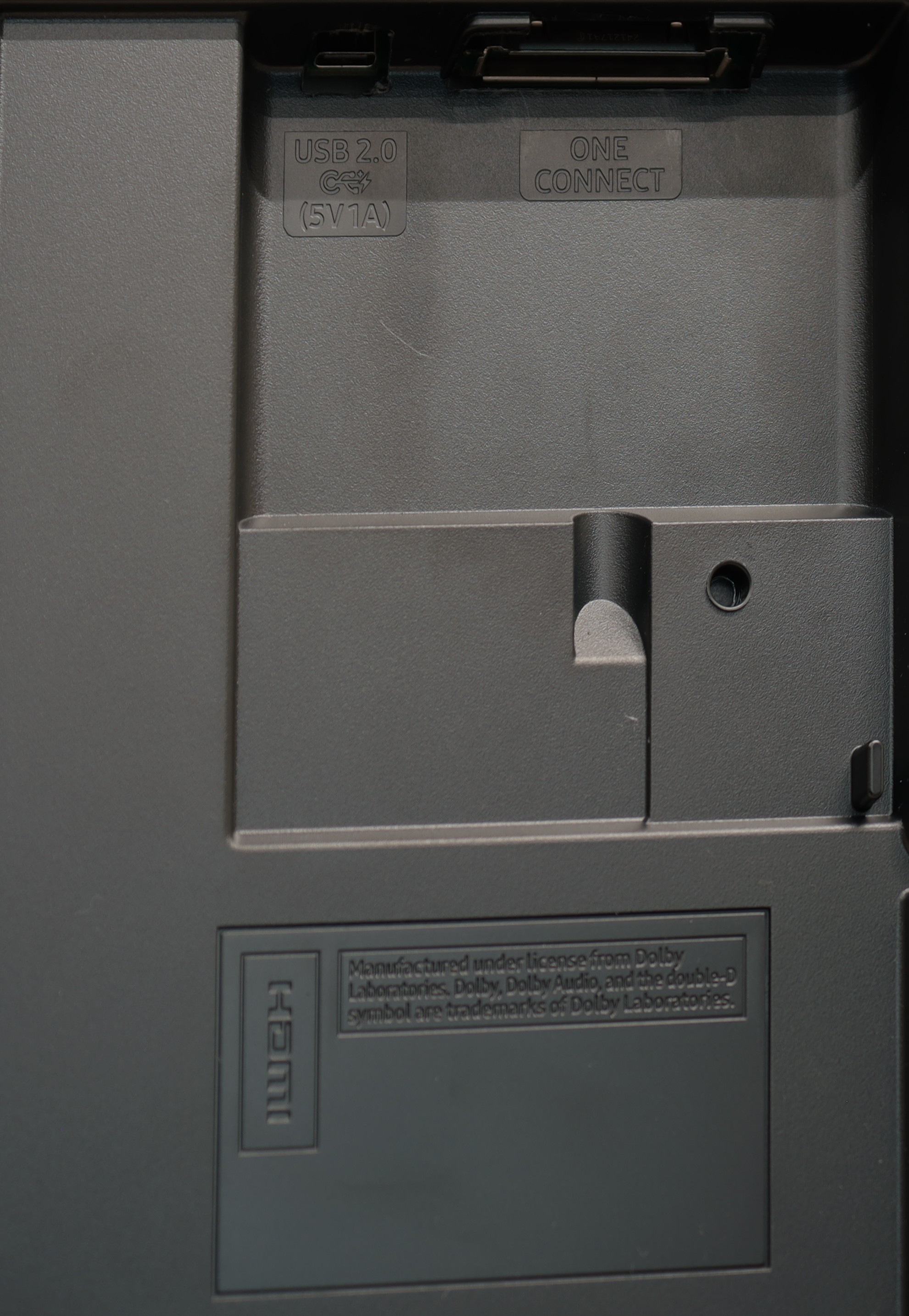
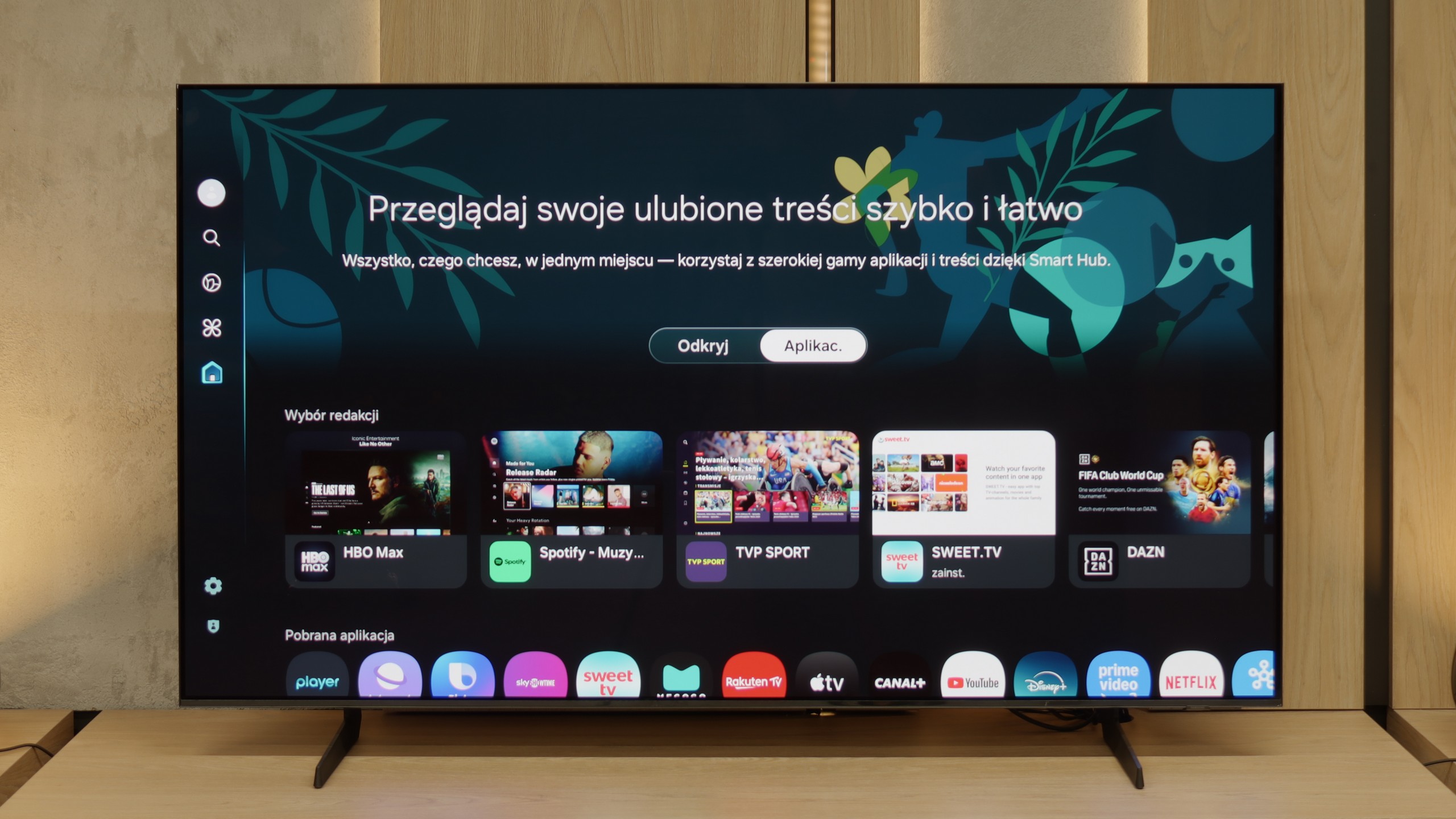
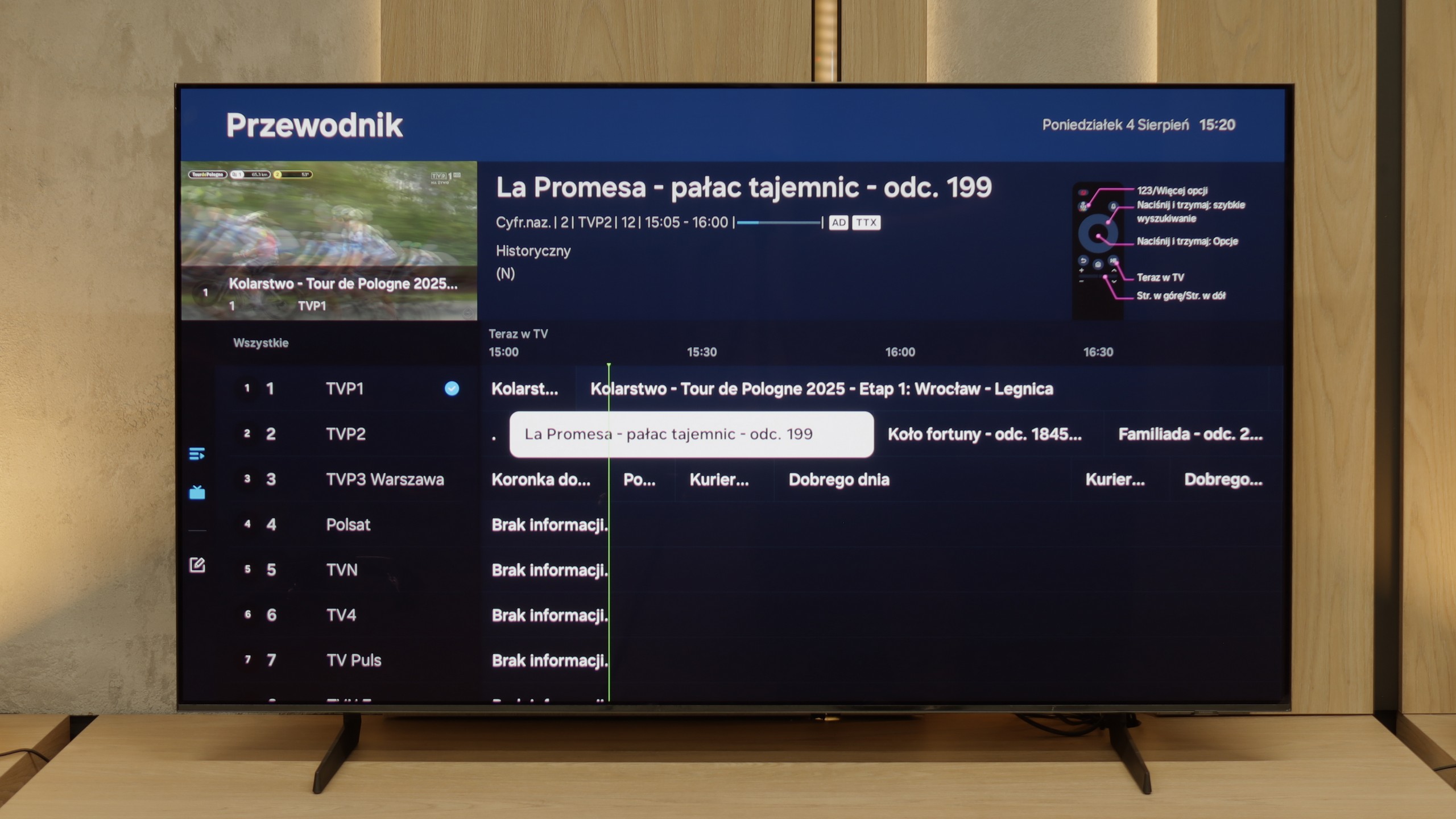
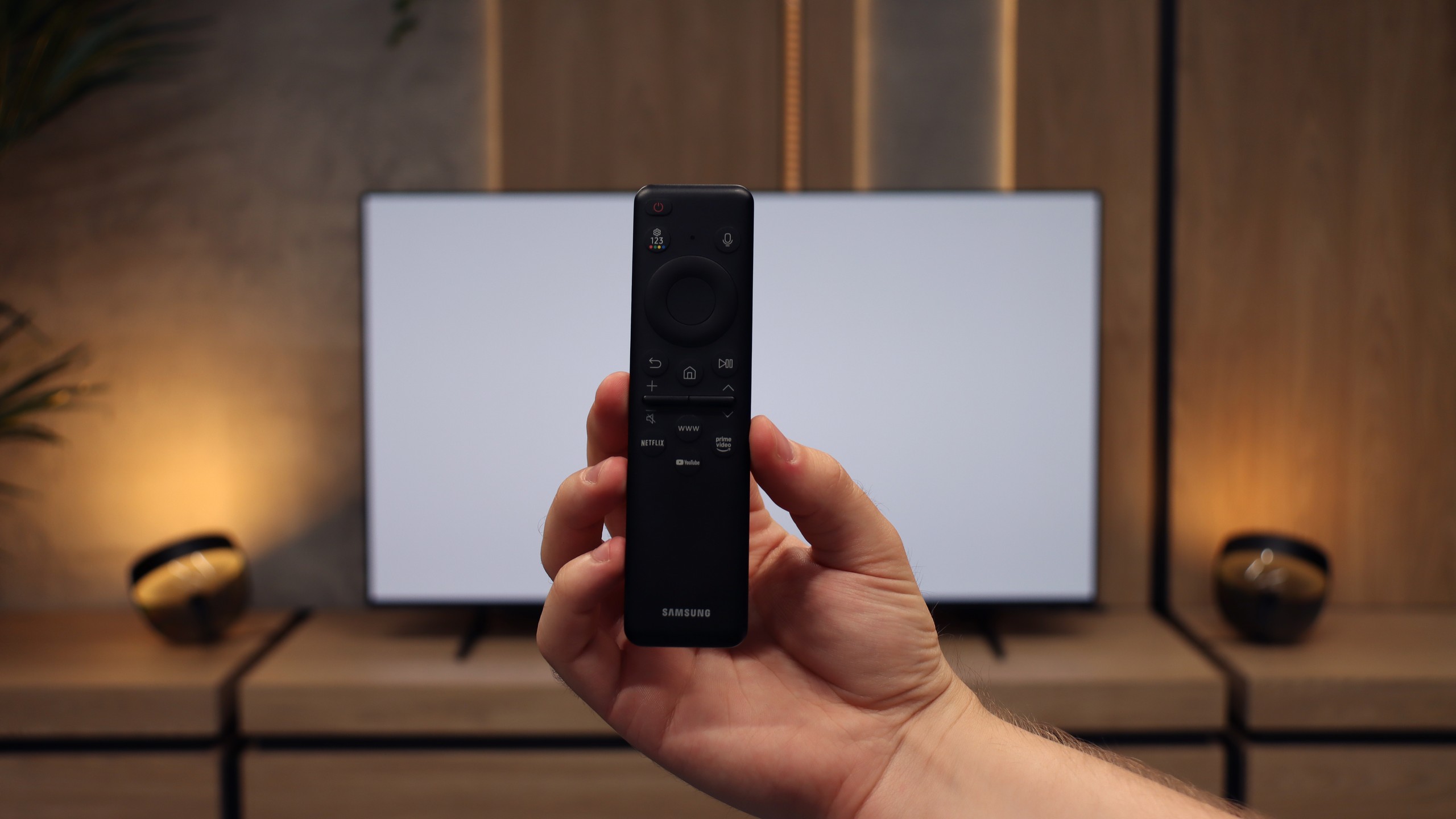

Classic TV Features
In terms of classic features, The Frame doesn’t stand out in any significant way compared to its competitors. There’s no option for USB recording or PiP (picture in picture), which may be disappointing for some users. On the other hand, the TV allows simultaneous use of speakers and headphones, which can be useful – especially for older users. The EPG, or electronic programme guide, is quite readable, and despite the absence of traditional buttons on the remote, we managed to launch even the teletext. In everyday use, the basic functions work smoothly and without major complaints.
Smart System – Tizen and Apps
The Frame 2025 runs on the Tizen system, which has been regarded as one of the most refined Smart TV solutions on the market for years. It’s a system designed for devices that are more than just a television – and it has been designed with this spirit in mind. Tizen offers full integration with external devices – supporting both Apple AirPlay and Miracast. Thanks to the SmartThings app, it’s possible to control not only the television but also other devices within the smart home framework. Since last year, Samsung has also been developing its own voice assistant with support for the Polish language, which significantly facilitates operation. However, the greatest strength of the Smart system in The Frame remains the Art Gallery app. Although access to it is paid (via subscription), it offers the best art scans on the market – we’re talking about scans, not just ordinary photos. This makes the effect of a digital painting hanging on the wall appear significantly better than in any other lifestyle TV.
Features of the classic S85F television
The S85F was not really designed with fans of classic television in mind. We won’t find a PiP function here (which is somewhat surprising, as Samsung typically offers it) or the ability to record programs onto USB from the built-in tuners. Fortunately, the basics are there – teletext and a clear channel guide – so it’s more than sufficient for regular, everyday viewing. The included remote, although simple at first glance and lacking a numeric keypad, allows for control of multiple devices. This means that when connecting, for example, a Canal+ decoder, you don’t need two remotes on the table – the one for the television is quite enough.
SmartTV S85F: Tizen
The smart part is a completely different story. Tizen is one of the most comprehensive operating systems in televisions. It operates smoothly, supports all popular internet functions – from screen mirroring to AirPlay to voice search. The strongest point of Tizen is its integration with the SmartThings app, which can act as a control centre for the entire home. Of course, like any closed system, Tizen has its limitations – for instance, a smaller app library compared to GoogleTV. However, looking at the current list of available applications, it’s hard to point out anything that might actually be missing.
Playing files from USB
8.5/10
9.1/10
Supported photo formats:
Maximum photo resolution:

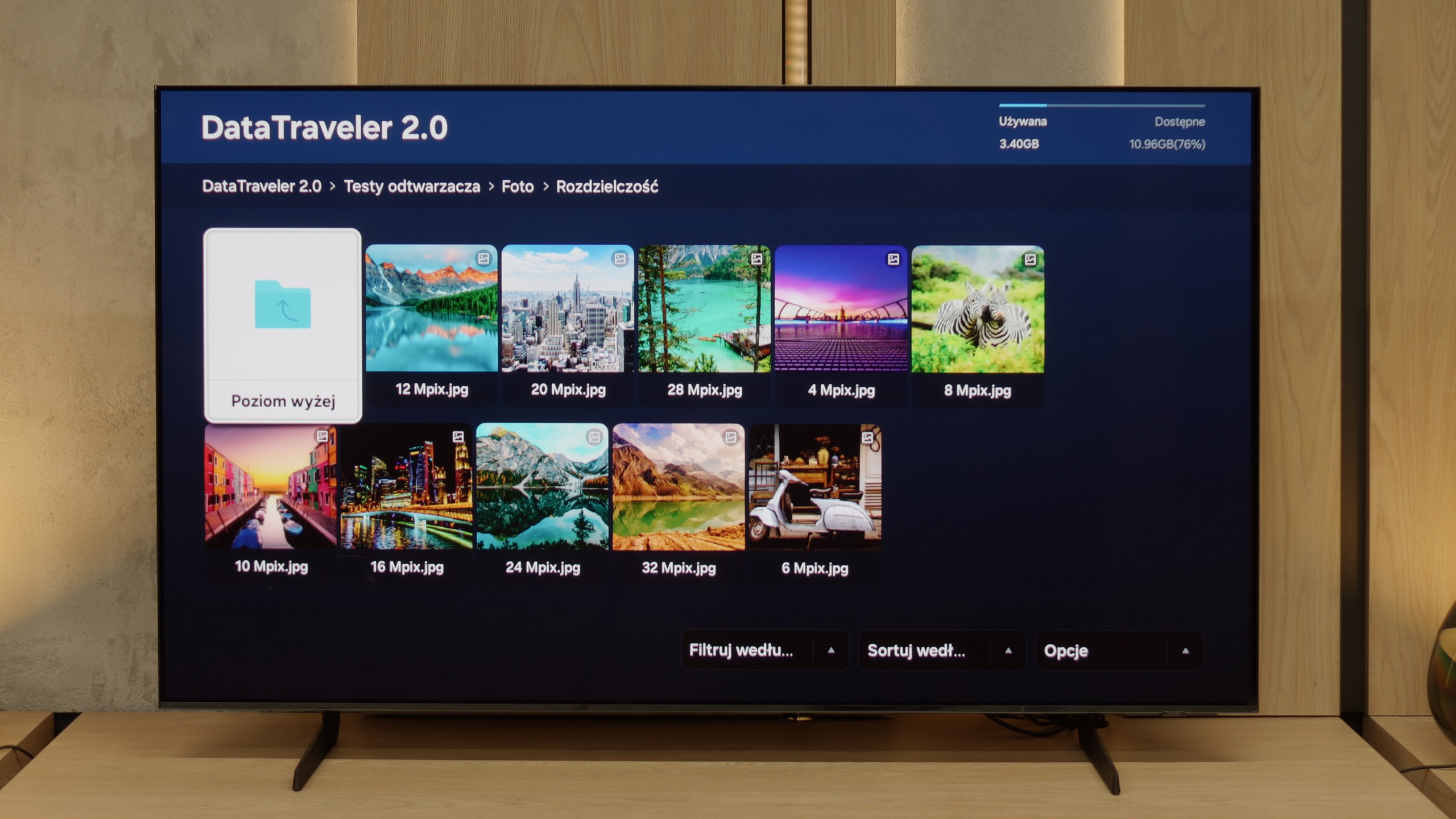
During testing, we didn't notice any major issues with playing files from a USB memory stick. The television handled both video materials and photos well. Of course, there are some exceptions – for example, the lack of support for the HEIC format (used by Apple devices) – but it's hard to consider this surprising. On the positive side, it fully supports high-resolution photos – the television displays high megapixel files without any problems, which can be significant for those wanting to treat The Frame as a digital photo frame as well. However, during testing, we noticed a limitation regarding subtitles – the television only correctly handled files in .txt format. It's worth keeping this in mind and ensuring that downloaded subtitles for films are saved in this format; otherwise, they may simply not display.
The built-in media player in the S85F performs excellently – practically everything you throw on a USB stick or hard drive will be played back without the slightest issue. Minor shortcomings only arise in the support of some less common photo formats, but for the vast majority of you, this will be more than sufficient. Therefore, it can be confidently stated that for home use, the built-in player is more than solid.
Apps
8.7/10
8.7/10














































Sound
6/10
7.2/10
- Subjective sound quality:6/107.2/10
- Dolby Digital Plus 7.1:
- Dolby True HD 7.1:
- Dolby Atmos in Dolby Digital Plus (JOC):
- Dolby Atmos in Dolby True HD:
- DTS:X in DTS-HD MA:
- DTS-HD Master Audio:
For such a slim television, the sound is quite decent. It’s full, adequate for everyday viewing, but lacks much excitement – typical of flat designs. There's not much bass, although at times it can be heard. The speakers in a 2.0.2 configuration have a total power of 40 W. (in the 55+ inch version) Unfortunately, the television does not support DTS format, so for movies with that sound, you'll need to rely on external equipment, like a home theatre system. You can connect a soundbar, and thanks to the Q-Symphony feature, the television plays along with it. Samsung also offers visually matching models for The Frame like S700D or S800D, but they are sold separately. (This shouldn’t really surprise anyone😉).
The built-in speakers rated at 20 W on paper may not seem impressive, but in practice, the S85F can be surprising. It sounds really pleasant, and at times you can even pick up a subtle bass, which is not a given in this class of speakers. The TV does not support the DTS format, which unfortunately became a standard for most manufacturers by 2025. A nice surprise is the support for Dolby Atmos. Of course, talking about "spatial" sound with two speakers located at the bottom of the casing would be a slight exaggeration, but it's good that Samsung offers such a feature in this model at all.


